Spears of the Dawn by Libertad!
System Overview
Original SA post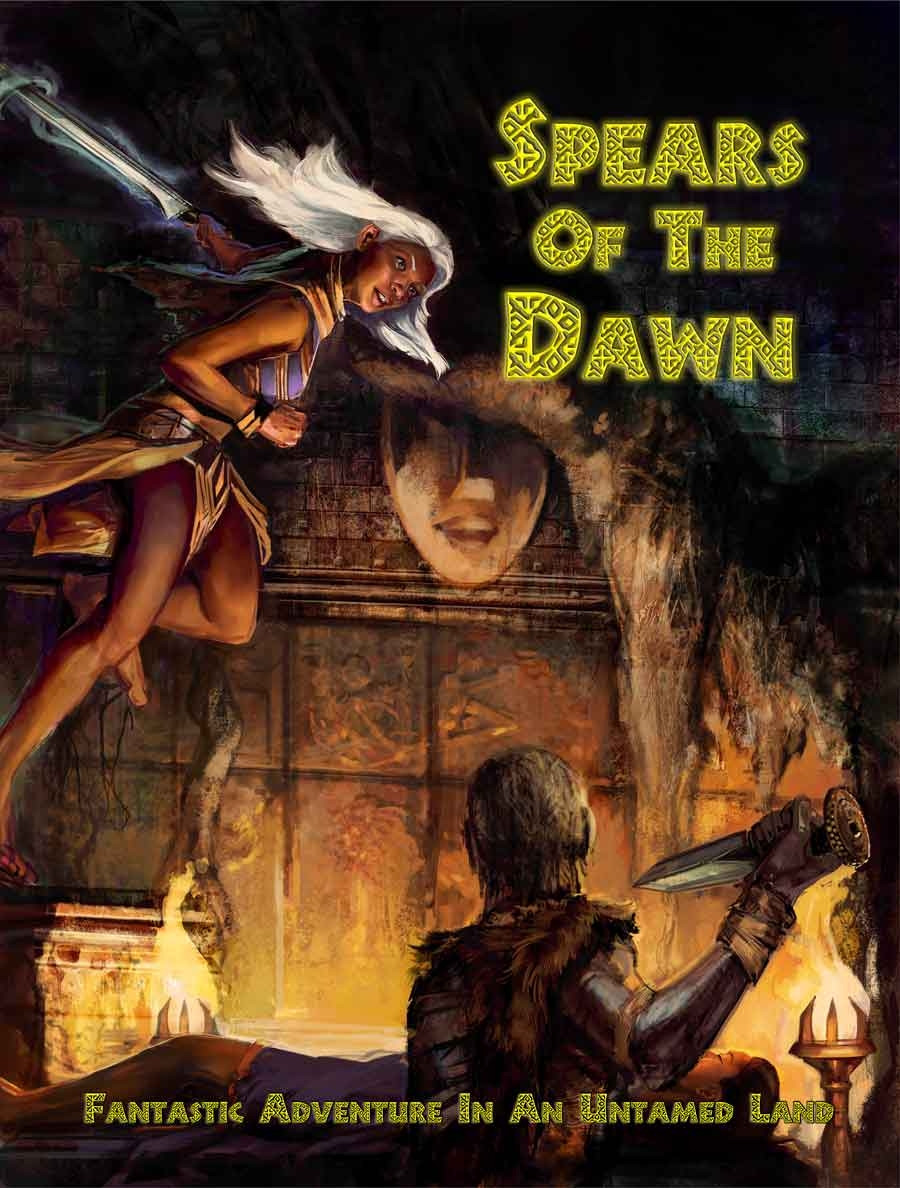
Once upon a time, there was a guy named Kevin Crawford. He designed role-playing games of the old-school variety, namely Dungeons & Dragons retroclones and supplements. He was hanging out on an RPG message board when the topic of racial diversity in games came up, and he heard the familiar mantra "That doesn't sell!" repeated. "Gamers aren't interested in fantasy Africa, they just want European and Asian (namely Japanese) stuff!" This irked Crawford, a lot, and so he decided to hedge a $3,000 bet. He bet that not only could he design a cool Fantasy Counterpart Africa RPG drawing inspiration from authentic myths, folklore, and history, but that it would be popular. To that end he buried himself in several months worth of game design and research on the continent in medieval times, hired a bunch of talented artists (whose work he released into the public domain with their consent to provide inspiration to others), organized a Kickstarter for funding, all to make a superb RPG.
And he succeeded. Not only did Spears of the Dawn get a lot of rave reviews and managed to avoid the more racist and stereotypical "unga bunga land" portrayals earlier work engaged in, it became one of the hottest-selling D&D retroclones on Drive-Thru RPG last year. The whole "fantastic adventure in an untamed land" phrase is sort of unfortunate to me, as it conjures up specific imagery which is largely inaccurate of the setting inside. There are definitely lots of ruins to explore and tiny isolated villages, but there are also great nations inspired by the real-world empires of Ghana, Mali, and Songhai which built grand palaces and possess the knowledge of metallurgy, an order of Paladin-esque Sunriders who defend the common folk from evil humans and monsters, and mighty sorcerers and clerics who have the king's ear and can decide the fate of entire communities. The setting's about as "advanced" as most D&D settings are.
System Overview
Spears of the Dawn derives its ruleset from Stars Without Number, another retroclone designed by Kevin Crawford, which in turn derives inspiration from the Frank Mentzer-written version of Basic Dungeons & Dragons. It adopts plenty of classic tropes, from the 6 ability scores to saving throws, although its classes, magic, weapons, monsters, and more take on the trappings of African folklore and legends. There are many varieties of sapient supernatural species, although only humans are a playable option (who in turn gain different starting skills based on their background).
As for the classes, there is the Griot (pronounced "GREE-oh"), bards and historians whose songs and orations are so good they might as well be magic; the Marabout (pronounced "MAHR-ah-boo"), priests who have a special connection with spirits and gods and can work their magic in this world by gaining their favor; the Nganga (pronounced "GAHN-gah"), people born with the ability to manipulate ashe, the fundamental potency of existence, which gives heat to fire, hardness to stone, and cunningness to the wise among other things; and the Warrior, those who do not rely upon magic or the griot's songs to perform feats of heroism. In addition to being the hardiest and most-skilled of the classes, warriors gain access to idahuns, or "replies," special abilities which the warrior has mastered to use against foes. Yes, fighters have class features nobody else gets or can easily replicate in Spears of the Dawn (and I'm not talking about piddly stuff like Weapon Specialization)!
The game also incorporates a skill system, unlike much of its fellow old-school brethren. It lies somewhere in between the complexity of 3rd Edition's fiddlyness and the "say what you want to do, DM sets the DC" minimalism of most OSR games.
Setting Introduction
In times long past the kingdom of Deshur warred against the Nyalan Empire. Out of sheer desperation, the Deshurite King turned to evil magic to turn the tide of war, and in turn doomed his own people to unending unlife. The Eternal, as they became known, were little more than undead monsters who cut an orgy of destruction across the Three Lands. Were it not for an alliance of the five major nations, they might have even been victorious, but mighty heroes with the help of the nation's armies organized resistance against them.
It has been forty years since the Eternal were driven back into the inhospitable black sands of the east, but remnants of their soldiers and sorcerers still lie in fortified underground strongholds and tombs, biding their time and striking out against those too foolish or unknowing that tread too closely. The past is forgotten as the five kingdoms remember old disputes and sever alliances, as border quarrels deniable incidents sprout up along their borders. Whether it's tyrannical nobles, bandits and monsters lurking in the wilderness, the troubles of the Three Lands seem beyond the reach of even its kings and queens.
It is a time of trouble, but there is still hope. In addition to wandering adventurers who slay monsters plaguing villages, spiritual leaders who call upon spirits to aid the sick, and sorcerers who break the curses of their evil brethren, there are the Spears of the Dawn. An organization formed by the last Nyalan emperor to fight the Eternal, these men and women come from all nations and walks of life to travel wherever they're most needed and wipe out the undead remnants. Today they are on hard times, no longer officially supported by any kingdom and often little more than wandering adventures. It is expected that the Player Characters number among the members of this heroic order.
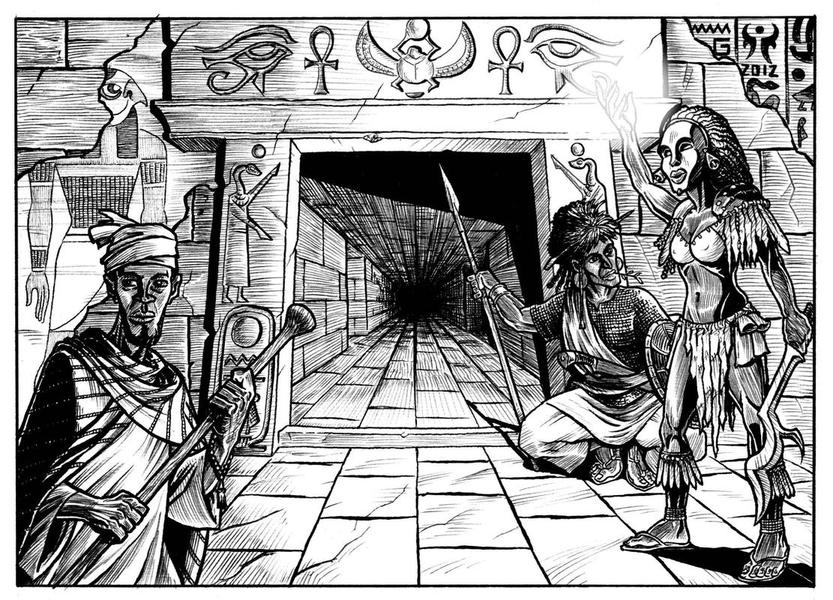
Adventurers getting ready to explore an Eternal tomb.
It might be odd to end my first post on the introduction, but the first chapter of character creation covers a lot of ground which I believe is served better in its own section. Hopefully I've whet your appetite regarding this RPG to look forward to more updates!
Next time, Chapter One, Part One: Ability Scores, Homeland and Backgrounds, and Classes!
Creating a Character
Original SA post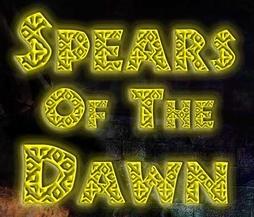
Chapter One: Creating a Character
The chapter starts off with some pretty basic information you see in plenty of RPG corebooks. "Try to design characters so that they work well together and have a common goal," "choose a motivation," "explain how/why your PC came to be a Spear (of the Dawn)," but it also says that the game is intended to be a sandbox game. Basically, one where the players decide on what to do and where to go in the world, and the DM reacts to this, and that there's no narrative plot armor built into the rules to save you from poor choices. The specifics of sandbox gaming are dealt with in a later chapter, and you can find many discussions of this playstyle on old school D&D blogs and message boards.
Attributes
First off, we have the classic 6 ability scores, which are known as attributes in this game: Strength, Intelligence, Wisdom, Dexterity, Constitution, and Charisma. Rolling 3d6 six times is the classic way of generating them, although one can remove points from attributes above 13 to add to ones below 8, but not to the point where the former dips below 13 or the latter increases beyond 8. The reason for this is that 8-13 is the baseline average, with a 0 modifier. A range of 4-7 grants a -1 modifier, 3 a -2, 14-17 a +1, and the vaunted 18 a +2. This way you can shore up pathetic ability scores from high attributes you don't really need. Each class also has 2 Prime Attributes, which are vitally important to that class and thus allow you to bump up an attribute to 14 in one of them if it's lower.
If you want, you can dispense with rolling and put a value of 7, 11, or 14 in your attributes, provided you don't have more 14s than 7s. You don't get your "free 14" prime attribute if you go this route, though.
Origin
Not that you've got your attributes and character concept, you move on to the next step, your Origin. This is a combination of your character's homeland (usually one of the five Kingdoms), and their background (the occupation/way of life he grew up with in said country). Your background does not restrict what class you can choose, but it instead provides 6 skills which your character starts with in basic competency (Level 0). If your chosen class gains one or more of these skills as bonus skills, then you move up to the next level of competency (Level 1), which indicates a long professional expertise. Therefore, it can be advantageous to choose a background which fits with your class. If your DM's okay with it and it sounds plausible enough, you can design your own custom background by picking 6 skills.
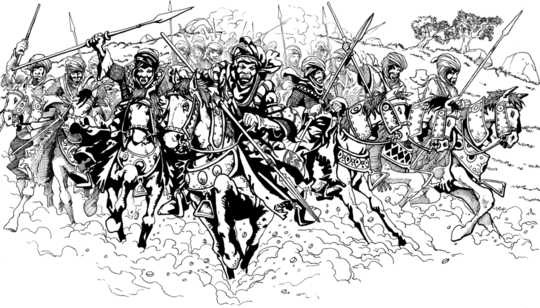
The Kirsi ("KEER-see"), formerly an eastern province of the Nyalan Empire, are a hilly nation of warriors famed for their armored lancers and iron-clad cavalry who cut through Eternal legions in the days of the Long War. Even the most impoverished peasant among them is taught in at least one kind of weapon, and their rulers wouldn't dare think of disarming the populace. For the last 40 years the nation's feuding noble houses engaged in successions of land takeovers and skirmishes, displacing many Kirsi and sending once-mighty family dynasties into exile. Even the kingdom's ruler, the Dia, can only enforce the territory his men walk over. Their cities are made of adobe and scrub-oak, their palaces and manors of quarried stone.
Many of their backgrounds tend towards some martial inclination (bandit, noble, scout, soldier), although the most interesting one's the Sunrider: your PC grew up training under paladins of the Sun Faith, who fight for justice and defend the common folk from noble depredations.
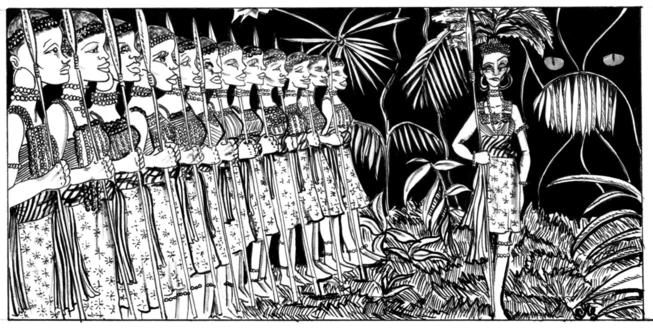
The people of Lokossa ("low-KOH-sah") live in a the southern rainforest kingdom of the Green Land, standing stalwart against the monstrous Night Men who lurk across the Akpara River. Their society is a tyrannical magocracy, where the nobles are mighty Ngangas ruled by the Ahonsu (sorcerer-king). Their magical protections and rituals kept their nation autonomous and repelled foreign threats for centuries, although the mages rule the commoners with an iron fist and work them to the bone. Whenever the Night Men grow strong, the noble clans selected human sacrifices among the commoners and slaves to fuel their magical power, which is grimly accepted as a necessary evil (hundreds will die so that thousands may live"). The people wear little in the humid jungle aside form chiffon-light wraps of woven leaf fibers dyed in bright, beautiful colors.
Backgrounds tend to vary, from the lowly peasant and city-dwellers and runaway slaves, to commoners with magical talent plucked from their families to serve a noble house. The Lokossan Reapers are an all-female military unit of warriors who fight with signature two-handed "great razors," and have an honored place in Lokossan society.
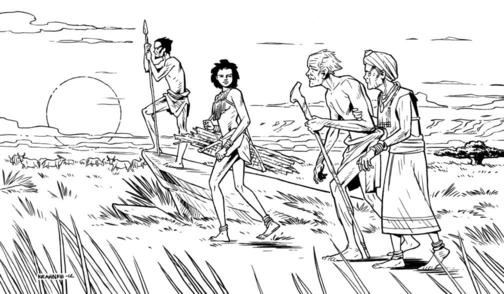
The Meru ("MAY-roo") are a nomadic people wander the golden savannahs and grasslands of the southern Yellow Land, dwelling in semi-permanent homes of thatches and thornbushes and taking their cattle to wherever the land is most plentiful. They are descended from the Sun Faith worshipers of the ruined kingdom of Deshur, when the rulers turned to the loathsome Gods Below for aid. The Sun Faith worshipers fled to the savannahs and learned how to survive from the indigenous groups living there. After generations of intermarriage they became the Meru people of today.
In the intervening years Eternal forces journeyed into the land to slaughter them, forcing them to ever be on the move. Eventually they turned the tide, fashioning war staves and throwing clubs to crush Eternal bones as their Marabouts seared their flesh with the power of the Sun. They are proud of the role they played in the Long War, and how their traveling life helped keep them one step ahead of their undead enemies. The Nyalan Empire in the days of old tried to claim the lands inhabited by the Meru, but were unable to effectively rule or tax them due to their legion's inability to even find the nomads in the great grass sea.
Meru are a religiously devout hunter-gatherer society, and their backgrounds reflect this (herder, scout, trader, etc). They don't have warriors or standing armies because everyone's expected to be able to defend their herds (although Meru Sunstaves are a background of gifted individuals who wield large staves as signature weapons). Olabans are loremasters who pass down the lore of their Sixth King ancestors to help counter supernatural threats, while their priests are Sun Teachers who have no temples or shrines but great knowledge in the holy scripture.
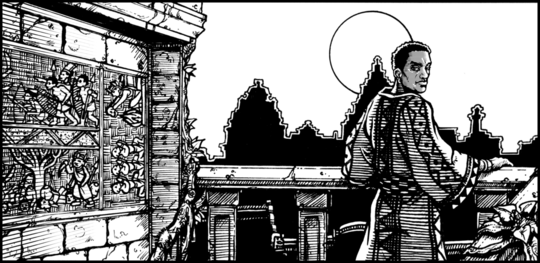
A once-proud civilization which ruled over much of the Three Lands, the Nyala Empire ("nn-YAH-lah") is but an empire in name only today. It is a northwestern land of rolling hills, meadows rich with water and rain, and beautiful broad-leafed forests. Their human ancestors learned many secrets from the giants of the Mountains of the Sun, which they used to work metal and erect grand buildings. As Nyala's land grew, so did its ambition, and it was this drive to conquer which drove the Deshirites into the eastern sands. When the Eternal marshaled their forces, the Nyalans were unprepared and spent most time holding onto existing provinces than to drive them back, which resulted in the loss of many regions and cities as well as the declarations of independence of Kirsi and Sokone. It wasn't until the days of the last Emperor Kaday that the country formed an alliance with its neighbors, formed the Spears of the Dawn, and drove back the Eternal. He died in battle, and now the Nyalans look to their recent past, reminded of all that they had lost.
Nyalans have a tendency to be proud and haughty; peasants and nobles alike have a near-encyclopedic knowledge of centuries-long family trees, and can make tenuous claims to great heroes and historical landmarks. Their nation might be in decline, with peasants burdened by heavier and heavier taxes, and dynasties see their fortunes decline and inability to protect their own land, and yet some of the most zealous venture beyond to find something, anything to make their country great again.
The backgrounds reflect this, ranging from Nyalan nobles or "hollow princes" who could no longer hold onto his land and legacy, artisans who blend elegance into even the coarsest of work, courtiers and hangers-on to the upper class and scheming plotters, historians forced onto a life on the road after being let go by a noble house, and even the mere peasant and soldier.
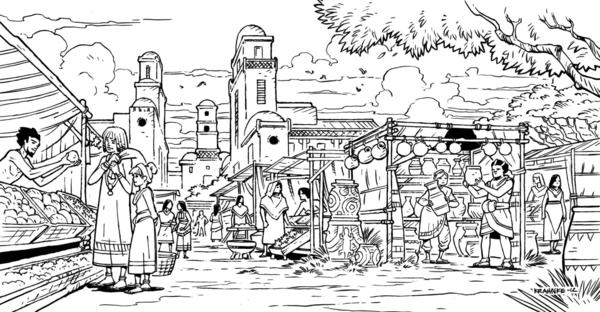
Our fifth and final nation, Sokone ("so-KOH-nay") is located in the relative center of the Three Lands, the mighty Iteru River cutting through the breadth of its fertile land. Sokone is the richest of the nations, home to cosmopolitan trade hubs importing and exporting all manner of goods, from rare rainforest herbs to fine Kirsi steeds. Almost anything can be for sale, provided one knows where to look and has the right connections.
Sokone was one of the first provinces to break away from Nyala in the time of the Long War. Although the Eternal armies were repelled by large bodies of water, the war was still devastating to the country. Their capital city of Chakiri was overrun and still serves as a stronghold for the undead to this day (now known as the Silent City). Farmlands and houses along the coastlines were burned so that even those who fled onto the safety of the river barges had nothing left to return to at their homes. Were it not for their geographical position among trade networks, and the merchant family’s wealth, it would’ve taken Sokone far longer to recover.
Sokone is the most racially and religiously diverse of the five kingdoms. From the jewel-colored eyes of Nyalan nobles to the stern features of the Kirsi, the traits of the major ethnicities can be found in all combinations among Sokone. Temples of the Sun Faith and shrines to all manner of spirits are common features along active city streets. Clans and families have little reluctance towards marrying foreigners, and alliances form more around trade and business opportunities than matters of nobility or lineage. On the other hand, the people of Sokone are very individualistic, and families are expected to stand on their own two feet with minimal outside help.
Sokone backgrounds tend towards mercantile varieties, such as the arbiter who is trained to settle disputes (both legal and otherwise), artisans, traders, and entertainers earning a living, riders employed by rich merchants to monitor the affairs of distant lands and return to them with news, peasants and riverfolk who perform labor in the rice fields and live day and night on traveling barges, and syncretic priests who call upon all manner of known and unknown higher powers.
In short, the backgrounds serve their purpose, and none of them are what I'd call unbalanced. Granted, a few are more interesting than the others, but you should be able to design the character you want unless you're dead-set on some really weird backstory.
Choosing a Class
Player Characters in Spears of the Dawn are a cut above the cloth. While anybody can learn how to swing a sword, placate the spirits, or sing well, the powers and abilities of character classes are special in both their training and sheer potential for greatness, even at their lesser levels.
There are four classes to choose from: Griot, Marabout, Nganga, and Warrior. Once selected, you are locked into that role, and cannot trade in levels or multi-class as you might be able to in other RPGs. There is some variation in specific abilities, but overall each class tends to be good or specialized in some general area.
Each class has universal core traits: hit dice used to roll hit points, saving throws to resist negative effects, an attack bonus to determine their overall fighting capacity, prime attributes, and a list of class skills. Additionally, each class gains a list of bonus skills to receive basic competency in (or grow to Level 1 if they overlap with existing background skills), plus one in a class skill of the player's choice and one bonus skill which could be anything they want. Classes advance at the same rate of experience, and the maximum level in the game is 10.
I will be detailing the magic spells and effects, including Griot songs, in their own Chapter: Magic.
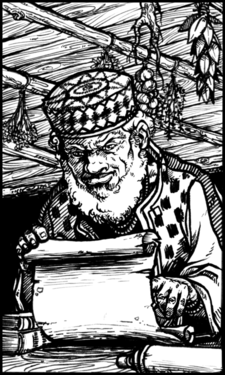
The Griot maintains the history and traditions of a culture's people. They are responsible for judging the worthy and the wicked, share their memories and lore with others, and channel the truthfulness of things through their praise-songs and verbal castigations. In short, they are the "bard class." They're rather squishy (1d6 hit dice), have an average attack bonus, and their saves are geared more towards evasion and avoiding mental effects, but they have a versatile list of class skills to reflect their role as scholarly entertainers.
Their major class features are their Songs, near-magical effects which increase in power as the griot gains levels. Whether it takes the form of a song, oration, chant, or other verbal sound, listeners realize that the griot is no ordinary entertainer and that these words carry a substantial, visible weight. Basically, a griot begins play knowing two songs and can learn an additional one every time they gain a level (or learning it from a fellow griot or tome they penned), and use a point-based system where songs cost a number of Inspiration to use. Using a song takes great effort, and too many in quick succession can tax the griot as they become unable to use the right words and melodies in the right order and fashion. At 1st level they can learn only minor songs, but at 4th and 7th they can learn Great and Ancient Songs. Their 10th level capstone ability allows them to pick 2 minor songs and use them at no Inspiration cost. Songs generally involve placing targets in a certain estate, bolstering the abilities of allies, or relying upon epics and lore to discover and remember old knowledge.
Overall, a class which is good at what it does and fits in well with the setting.
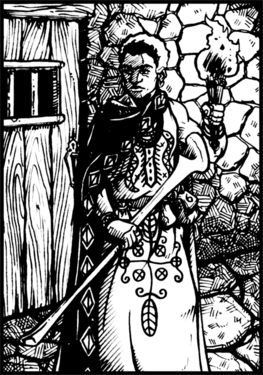
Every village has its people versed in their culture's religion and the service of the spirits. Religious festivals and celebrations are communal activities, as the favor of those worshiped is seen as the duty of everyone and not a specialized order of clergy. Even then, there are times when the specialized skills of one close to the spirits is needed, and the Marabout serves that role.
Marabout are not just priests and priestesses. They are people who fashioned close relations with a spirit or spirits, and in exchange they gain magical powers in line with the spirits portfolio. Some have to spend years earning their good will, while some are born able to use miracles by instinct, having been watched by an otherworldly patron since they were in the womb. Most marabout in the Three Lands follow either the Spirit Way (catch-all term for people who honor all variety of spirits) or the Sun Faith (monolatrist faith which views the Sun as the greatest spirit of all and pay homage to him and him alone).
Marabouts have a 1d6 hit dice and average attack bonus, and their saves are more geared towards resisting magic and saving them in times of pure luck. Their skill list is fewer than the griot's, generally a few social skills and knowledges. Their primary class feature is their access to Spheres, which are much like Cleric domains from Dungeons & Dragons geared towards a certain theme, and and one of them chosen by the PC grants an always-active Gift or benefit for the Marabout. A marabout PC chooses two spheres at 1st level, representing their friendship with spirits in that portfolio. Alliances can change and evolve, however, and the marabout can gain an additional sphere at 3rd, 6th, and 9th level, and can trade out any number of spheres whenever they gain a level. Marabouts of the Sun Faith, however, must always keep the Sun sphere as one of their active spheres. In exchange, they can cast one more spell per day per spell level.
Marabouts use the all too familiar Vancian spell system, where they spend slots of certain spell levels to cast their spells. Whereas standard D&D clerics and wizards can choose their spells ahead of time, marabouts can only cast spells from their spheres. At 10th level they may choose a 1st level spell of a sphere without a permanent effect to be able to cast at will. This makes the class rather specialized at low levels, although they become more versatile in ability as they gain levels.
The eight available spheres are Curing (healing magic and immunity to disease Gift), Death (weakening enemies, speaking with the dead and raising the dead, can halt bleeding others as a Gift), Herding (good with animals and +1 to your Constitution modifier Gift), Passion (manipulate emotions, +1 to Charisma modifier Gift), Spirits (banish and summon spirits, can speak with spirits and see them as your Gift), Sun (light and fire magic, see in perfect darkness and radiate light at will as Gift, available to both Spirit Way and Sun Faith), War (buff spells for combat, +1 to hit rolls with specific weapon group as Gift), and Water (water and weather magic, can breath and swim in water like a fish as Gift).
The Marabout's role in the party highly depends upon the spheres you select. They can be classic battle-priests of D&D with Curing and War, they can be pseudo-druids with Herding and Water, and classic undead-slayers with Spirit and Sun. The choices are up to you!
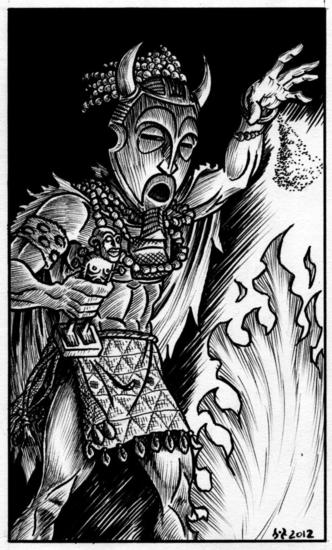
The Nganga are those few people gifted (or cursed, depending on how you look at it) at manipulating the universal force known as ashe. This art is inborn and cannot be taught, although most of these folk are destined to live unaware of it, their unconscious desires wreaking magic around them. However, with proper training and knowledge of the required rituals and material components, a nganga can achieve feats both wondrous and terrible. From laying curses upon foes to taking the forms of beasts, the magic wielded by a nganga makes them feared and respected across the Three Lands. As long as they restrict their magic to cursing enemies and warding their own communities against evil magic, these sorcerers are tolerated as a necessary evil (or are part of the ruling class in the case of Lokossa).
The Nganga is very frail, with a d4 hit dice and the only one which does not have Combat skills as class skills, and a poor base attack bonus. Their saves are geared against resisting magic and mental effects, and are bad at resisting physical effects and evading danger.
While a Griot's songs are not technically magical, and the Marabout relies upon spirits from another world, the Nganga's magic is entirely internal and of this world. They need to channel their powers into proper receptacles, forcing them to carry specific charms, masks, pieces of clothing, and similar restrictions to cast their spells. Unlike marabouts, they cannot cast spells while wearing armor. Nganga Sorcery is divided into two kinds: ritual spells, which has no limit to the number of times they can be cast but often have long casting times (30 minutes is the fastest one of all) and sometimes expensive material costs. And nkisi spells, which use the per-day Vancian system and must be imbued into nkisi, or small handheld objects. Both have spell levels, and thus can only be learned by a nganga who meets the proper character level to cast them. They can learn new spells by gaining levels or from a fellow tutor (none of which freely part with their knowledge, and prefer favors and quests to vulgar trade goods). A nganga always has the option of preparing more slots than their level allows via additional nkisi, but failing an Occult skill check causes all of the spells to go off at once with the nganga as the target.
Nganga are a potentially powerful class. They are more versatile than the marabout, and many of them tend to be direct damage, debilitating curses, or defensive wards or rituals to build minor magic items. They do suffer the common problem of low-level old school wizards, where they can fire off only a single spell at 1st level and become squishy targets with almost no offensive capabilities.
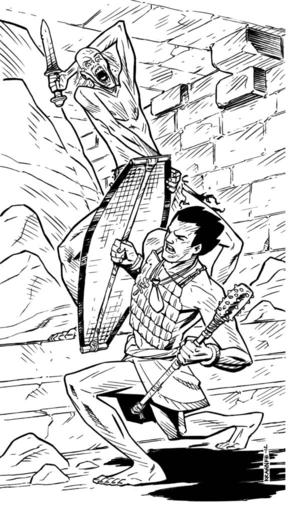
The Warrior has a rather misleading name. Although they are mechanically combat-based, the available options allow you to make a skilled thief character. Warriors are pretty much anyone who relies upon their own skill and wits without the aid of magic or songs. Fighters not only have the best hit dice (d8) and attack bonus, their saves are good all across the board, and they gain athletics and all combat skills as bonus skills. And their class skills are not too shabby either, including the aforementioned groups as well as more thiefy stuff.
Warriors gain access to idahuns, or "replies," techniques they mastered through training. Almost all of them are always-active, only a few are limited use. The warrior gains an idahun of their choice at 1st level and gains an additional one at 3rd level and every odd-numbered level thereafter. There are 12 total, enough for me to cover them all. They tend to vary in effectiveness, with some useful for any character and a few dedicated more towards specific builds. What I like is that some of them are open-ended as to whether they might be supernatural, or just superior training or luck. For example, the "Two Lives" idahun might be the warrior simply possessing extraordinary luck, or the spirits are watching over him.
The four great ones, which any build can improve upon, are:
Blessed and Graced is great because your PC gains an effective 7 points of armor bonus (equivalent to heavy armor), as they learned to fight unarmored. They can still use a shield, and there's no downside to this as it's superior all available armor options with none of the drawbacks. You won't be able to use this while wearing magical armor, but you won't find that stuff often until higher levels.
Charmed Steel, where your attacks wound all foes normally, even if they'd otherwise be immune to or suffer reduced damage based on weapon type. Additionally, all weapons and armor you wield are treated as magical, and gain a +1 bonus at 4th level and increase by 1 every 3 levels.
Two Lives, where you simply fall unconscious for 5 minutes if you'd otherwise die or bleed out from your wounds. You can die normally if struck while in this state, and must spend a week in celebration to honor the spirits who saved you or being joyful over your good luck before you can use it again.
Washer of Spears, which grants +2 initiative and you can never be caught surprised.
And for the rest:
Born with a Blade is lackluster, granting you a +1 to hit and +2 damage with a weapon group of your choice.
Deep-Rooted Soul grants you a +2 on magic saves (putting you equivalent with the Nganga, the best magic save in the game), and you can't suffer negative levels from energy drain. Useful for most builds, especially magic-using enemies and undead.
Honed Skill and Sagacious Warrior are meant for the skill-user builds. The former lets you pick one skill you're really good at, and you treat a roll as a 12 on the die (2d6 skill system) once per day. Sagacious Warrior grants you basic proficiency in 3 skills of your choice or raises existing ones to Level 1, or any combination thereof. This last idahun, along with all others, can only be taken once.
Dreadful Shadow and Honored Steps are reputation-based, and only one of which can be taken. The former grants you bonuses on intimidation-based rolls, and you're immune to all fear effects. Honored Steps increases your Charisma modifier by 1 and automatically assumed fit for leadership positions. Both are rather situational.
Tireless increases your Constitution modifier by one (augmenting your hit points), and you can perform physical exertions all day long, and you sleep light for the first four hours. An all-around good idahun.
And finally, Roof of Spears. Once per combat, you can instantly move to interpose yourself with an ally within 30 feet, taking the damage or effect meant for them, even after dice are rolled. You can only defend against physical attacks. Good to have if one of your PCs is wounded or a squishy nganga.
Overall, I really like the Warrior class. It is very versatile both in and out of combat, and I like the touch of unique class features with good effects. It makes the warrior feel unique belong "have the best hit points and saves and all the proficiencies" of other old-school fighter classes.
Skills
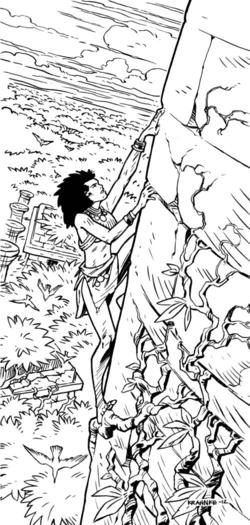
The other major aspect of character creation, Spears of the Dawn uses a skill system. Skills range in 6 variables: lack of a skill, where you don't have even basic training and suffer a -2 penalty (and can't even roll for harder DCs at all); Level 0, basic proficiency; Level 1, years of training; and all the way up to Level 4, which indicates legendary ability.
When performing an activity with a reasonable chance or consequences of failure, a character rolls 2d6 and adds their skill level and the attribute modifier most relevant to the situation, with DCs ranging from 6 (simple tasks for trained people) to 15 (barely possible in a theoretical sense). There are 20 skills, a few of which have specializations. It costs points to upgrade skills, and characters have only a set amount per level to spend. The cost increases exponentially between skill levels, and more so if it's not a class skill, so even griots and warriors aren't going to be getting good at all of them anytime soon.
Some skills are specialized and require specific knowledge, such as Artistry (art and entertainment stuff), Culture (your own or others), and Trade (common medieval occupation), but most are broad and all-encompassing. Some skills especially useful to typical Spears or adventurers, such as Athletics (helps you wear heavy armor in hot climates in addition to movement stuff), Occult (supernatural stuff), Perception, Navigation (where am I?), and Survival (living off the land). You even have Persuade, a social skill to change people's disposition towards you, while Leadership and Tactics can help keep obedience of subjects and manage affairs in risky situations.
What's interesting is that Combat is a specialized skill. Instead of using the 2d6 system, you buy up skill levels in a certain type of weapon (axes, blades, clubs, spears, or missile weapons), and you add the skill level to your attack bonus along with the relevant ability modifier. This is in lieu of a proficiency system, and I sort of have mixed feelings on it. On the one hand, it complicates things when transferring from other games ("can I use this weapon or not?"), but it allows for some customization in what you're good at unlike some more restrictive retroclones.
Final Touches
The last bits of character creation include choosing of starting languages, rolling for starting wealth (with silver trade ingots the universal basis of currency) along with a table to gear to buy, and roll for starting hit points.
Unlike other retroclones, you roll your entire hit die value every time you level up. And if the total is equal to or greater than your current hit points, then you gain that new value instead. This results in the potential for sudden large increases, and can mitigate the effects of a bad roll the previous level. Rolled a 3 for your 1st level Warrior? Not to fear, upon hitting 2nd level you always have the potential to get as high as 16! Only problem is, there's the slight chance that you might not get any hit points at all upon leveling up.
Thoughts so far: I like what Crawford did with the classes. They're quite versatile for an old school retroclone, and the fluff text fits really well with the setting while letting you know this is not your standard Fantasy Europe. 3rd Edition fans like me might appreciate the skill system to better create your character, and the background system helps ground your character in the world.
Next time, Chapter Two: Systems and Rules!
Systems and Rules
Original SA post
Chapter Two: Systems and Rules
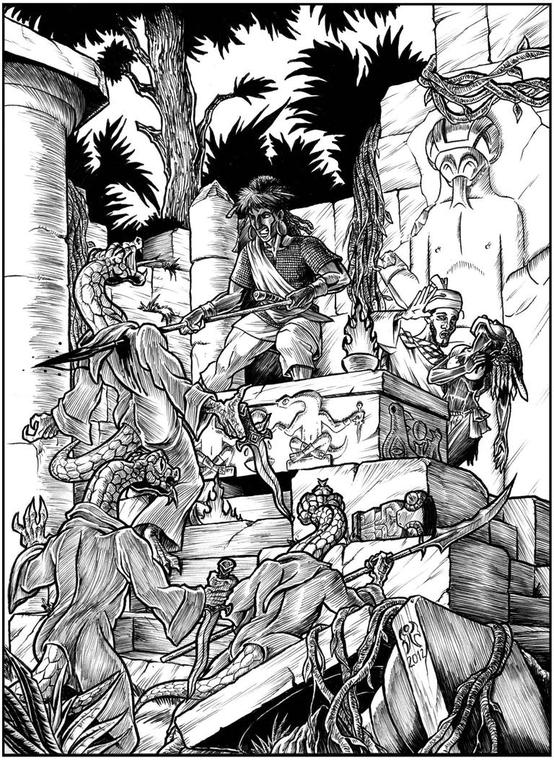
This chapter is a collection of all those common rules you see in RPG rulebooks covering plausible situations adventures might come across in play. Carrying capacity, overland travel, natural healing, that kind of stuff. It's an oddity that these rules are near the front of the book, but that actually makes sense. In other retroclones and D&D Editions, such a chapter's usually farther into the book, after magic and equipment and other stuff like that. But this is actually a good idea, as these rules apply to everyone, and they're only 10 pages long (in keeping with the rules-lite ascetic of many old school games).
Our first section are skill checks, covering the skill system of Spears of the Dawn. In short, you roll 2d6 and add your Skill level, the relevant ability modifier, and other miscellaneous modifiers as determined by the DM. There's no check for things where you can accomplish the task eventually where time is not an issue or something you do regularly for your background. Otherwise, the target number (or difficulty) are in intervals ranging from 6 (simple tasks for trained people) to 15 (almost impossible). Very open-ended.
Opposed rolls (like sneaking up on a sleeping monster) are done by the participants rolling opposed skill checks, with the higher result winning (ties are rerolled if they don't make sense in context).
Extended skill checks are rather simple, where the result of a success or failure determines if you finish in time when it's convenient, or is rolled once for each interval of time.
Also, good advice to discourage those asshole DMs who make players roll for everything:
quote:
As a good rule of thumb to determine whether or not a PC should get a concept success, think about whether failure would make the PC look incompetent at their role. If not-infrequent failure at a type of skill check would have gotten them drummed out of their profession, then they can be assumed to automatically succeed at similar tasks.
Don’t feel obliged to let a character’s concept creep too far. One who bills himself as a “jack of all trades” might well have a wide range of skills, but letting him get a concept success more than once a session is probably more than he needs. The goal is to let PCs be good at what they are about, not to let someone bypass half their challenges with a well-worded character concept.
We then get brief overviews of the five saving throws. Physical Effect involves stuff like resisting diseases, poisons, exhaustion, and other tests of health and endurance, Mental Effect covers griot songs and supernatural effects that directly affect your mind, Evasion covers situations where you must dodge out of the way of something, Magic covers any magical effect which does not follow under any of the following categories, and Luck for when your wellbeing hinges upon dumb luck and not skill.
Also, suffocation and falling damage. Long story short, you die if you go for 5 minutes without air (and bad stuff happens in the intervening minutes), and suffer 1d6 damage per 10 feet fallen (to a maximum of 20d6) with a luck save halving the damage.
Overland travel is rather straightforward, where the average human adult travels 3 miles an hour and can be modified by encumbrance, terrain, and any mounts they have.
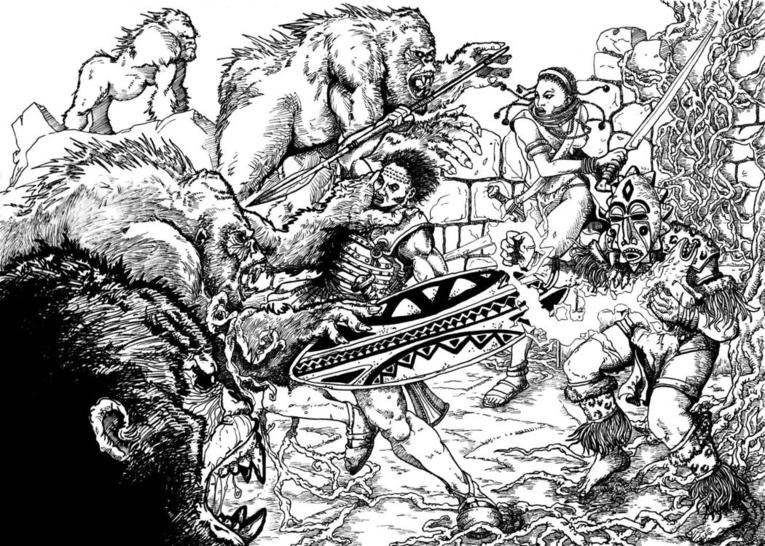
Combat is where we really get to the details! Surprisingly this section's only 2 pages long. Mainly it covers initiative (roll 1d8 and add dexterity modifier to see combat order), actions and movement (free actions which require nothing and normal actions which can be done in one round), spell disruption (ngangas and marabouts lose whatever spell they were in the process of casting if hit with an attack), movement (60 feet per round and one action, or 120 feet doing nothing but moving), and attack rolls.
Attack rolls are different in this game, in that the target number is always 20. An attacker rolls a d20 and adds their base attack bonus, their weapons skill level if applicable, relevant ability and miscellaneous modifiers, and the opponent's armor class (a lower value is better, naturally). There are no critical hits in this game.
Other than this, that's it for combat! Quite simple, really!
Encumbrance and armor determine carrying capacity. A character can ready a number of items equal to half their Strength score, ones a person can easily ready on their person and can be drawn as part of an action in a round. Armor counts as a readied action. You can have a number of stowed items equal to their Strength score. You can ready or store 2 or 4 additional items in exchange for becoming lightly or heavily encumbered, respectively.
Rather than listing out weight for all equipment, Spears of the Dawn list an Encumbrance number, determining general weight and unwieldiness. Most items are encumbrance one, and most small objects have no encumbrance. Items with an encumbrance score higher than 1 are tougher to carry, and thus count as additional ready or stored items.
Also, the hot climate of the Three Lands makes wearing heavy armor impractical in most situations, and thus are not in high supply or demand. You suffer hit point damage equal to twice its encumbrance if you wear it long-term. As such, most warriors don heavy armor immediately before battle or when they're going to fight mounted (riding reduces the penalty) or in the shade. Having ranks in the Athletics skill reduces the penalty.
Injury and healing are semi-detailed, where people reduced to 0 hit points are at risk of dying if not attended to with a successful Medicine roll of 8 or a healing spell, and must make Physical Effect rolls if left without treatment to avoid certain death. Bed rest can restore hit points equal to your level per day, twice that if you spend all day doing nothing but rest plus more if attended by someone with the Medicine skill.
Diseases and poisons have a Toxicity rating, which is the target number needed to resist it on a saving throw (physical effect or luck, player's choice) or a medicine roll to cure it.
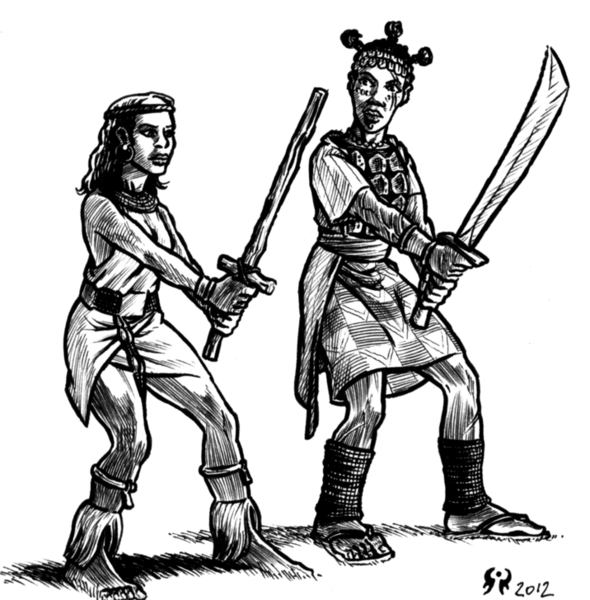
Character advancement explains the process of gaining levels. Basically, Spears of the Dawn uses a goal-focused method of accruing experience points. Monsters and treasure don't have set amounts, instead the DM has a provided table of experience points the party should gain every gaming session based on their current level. PCs should not be granted experience for accomplishing trivial tasks with no real risk. Upon gaining the requisite experience, they gain the level immediately along with all of their effects.
Also, we get into skill points. In addition to the bonus skills granted by background and class, PCs gain 4 skill points at 2nd level and each additional level thereafter. They can be saved in between levels for the purchase of future skills. As for skills themselves, costs for new skill levels is dependent upon both the level to be attained (levels must be purchased in order, no jumping from 0 to 3) and whether or not they're class skills. Additionally, PCs can't gain Skill Levels of 2, 3, and 4 until they're 3rd, 6th, and 9th character levels respectively (meaning skill masters are also very high level).
Buying a cross-class skill from 0 to 4 can cost as 20 skill points, while raising a class skill you had at Level 1 at character creation costs 12 points. So long-term planning and taking your background and class into account is encouraged from a game mechanics perspective.
There's also some brief rules on levels beyond 10. Basically you reroll your 10 hit dice every level until you get a better result, along with skill points, but nothing else. You and the DM decided on a single special ability for your PC for each "bonus" level in line with your accomplishments:
quote:
Instead, the PC receives a single new ability appropriate to his nature and heroic deeds, chosen by agreement between GM and player. For persistent, always-available abilities, they should be roughly as strong as a warrior’s idahun. For abilities that can only be used once per day, they might be as strong as a fifth level spell or ancient song. Such legendary heroes should advance in unique gifts rather than simple brute accumulation of bigger statistics.
We get a one page explanation for converting to other old school rulesets. Due to the relative interchangeability of game mechanics in OSR games, the biggest hurdle is the skill system (remove it or alter it) and armor class (subtract or add 20 based upon whether its descending or ascending).
Ending our chapter's a 1 page quick reference cheat sheet of the most important and relevant rules for quick reference. I haven't played a game yet, but this (along with the chapter's relative shortness) is sure to greatly speed up gameplay.
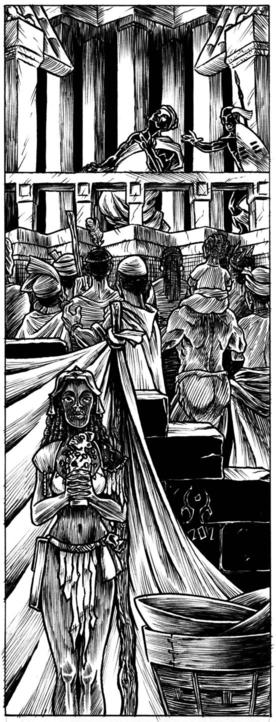
Thoughts so far: The rules are very short, yet cover most of the stuff relevant to fantasy adventuring. It's close to the book's front, easy to navigate, basically everything done right.
Magic
Original SA post
Chapter Three: Magic
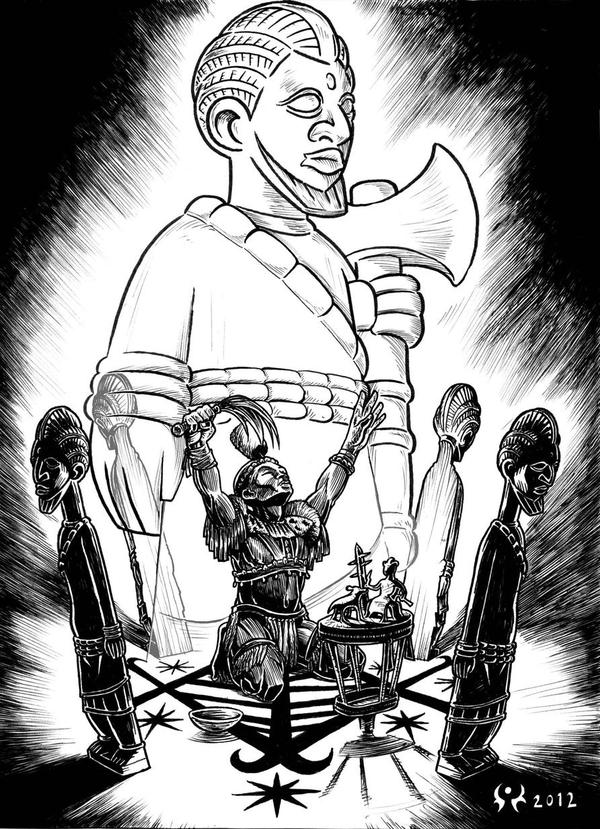
This chapter lays out the major features of 3 of the 4 classes of Spears of the Dawn: Griot songs and spells.
Before getting into each class, we have a general overview of how magic interacts with reality and how it's treated by the people.
Basically, magic comes in two varieties: the natural miracles of the griot and the marabout, and the manipulation of ashe of the nganga.
Miracles are fundamentally the product of natural law. The marabout appeals to spirits who have authority over certain aspects of reality, and in turn they change things to the marabout's favor. As for griots, their songs draw upon the social laws and cultural mores of their people, which are not just hollow concepts. Since marabouts and griots are drawing upon existing rules, they are easier to call up. Whereas a nganga must prepare their spells in rituals ahead of time, marabouts can call upon any spell they have access to in their spheres and a griot any song they know, the only limits being spell slots and inspiration points.
Ashe is different. It has nothing to do with the gods, spirits, or societies. It is more essential and fundamental to the make-up of this world, and typical used to alter and create such things. Curses, one of the nganga's most well-known spells, are effectively altering a person's supply of ashe to harm them in some way. Even skilled marabouts cannot permanently lift curses, due to the relative gap of difference between ashe and spirits. And those who are born with the potential to manipulate ashe are unable to control their powers effectively without tutoring under a more experienced user. It is for these reasons that it's distrusted among many religious people, who believe that it can sever the connection between mortal and spirit. It is also why many of these same people tolerate ngangas in their villages, to better counter the magic of evildoers of their kind and help train latent "witches" so that they don't accidentally curse their own friends and family.
Between the griot songs and marabout and nganga spells, there are 110 powers to choose from, and we'd be here all day if I outlined them all. Instead I'm going to do a general overview of the classes and spells, pointing out particularly interesting ones.
Griot Songs
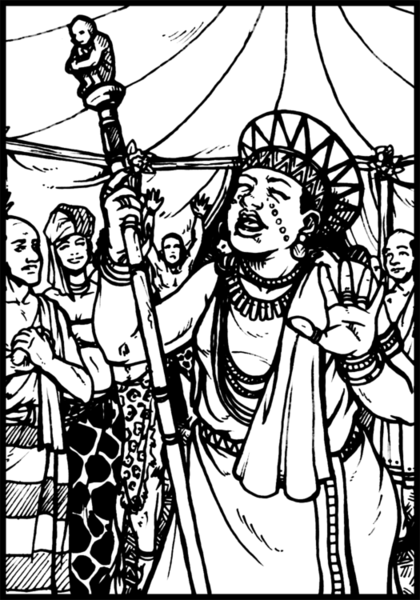
Griots are experienced in the art of songs, near-magical chants and orations which can inspire and enlighten others with newfound truths, and fell wrongdoers with judgment. As judges of the deeds of mortals, griots' powers are not constrained by any overarching code, and thus can use their songs as they see fit (although certain conditions must be met for some songs).
Despite being in the magic chapter and earlier lumped in with marabout spells, griot songs aren't technically magical, and thus aren't affected by magic wards or dispelling effects. In fact, many of the griot songs can be seen as entirely mundane, and can just as easily stem from them pure skill. I actually like this variation. It leaves the griot in a sort of nebulous state as to how much they're calling upon a greater power, and how much of it is them being just that good.
Also, unlike spells, griot songs can only be interrupted by an attack which would render the griot unconscious or dead.
There are 22 griot songs to choose from, 8 minor, 8 great, and 6 ancient. They are generally divided into praise-songs, which buff up the griot's allies with bonuses of various kinds; Remembrances, which are sort of like bardic knowledge in that the griot gains insight into a certain situation; songs which don't fit into either category.
Overall, griot songs are pretty sharply focused in comparison to spells. They generally enliven allies, reveal knowledge, and bestow mental and emotional effects upon enemies. Still, they're pretty useful to have in a party.
Griots can also scribe their songs into large books, which can take many months to complete. The most powerful griot songs can encompass multiple volumes, and all whose workings only grant true knowledge of the craft to fellow griots.
The minor songs are small, minor effects which won't do much by themselves and are most effective in conjunction with other actions. The praise-songs grant minor bonuses to skill checks (Praising the Artisan's Hands), attack rolls, armor class, and the remembrances invoke various songs, poems, and legends to remember simple words in a foreign language (Remembering the Correct Words), common customs, and historical facts (Remembering the Old Kings). The sole offensive song, Condemning the Wicked Man, is a verbal castigation which deals damage in the form of sapping their fighting spirit (it can't strike someone dead for this reason).
Great songs are overall more powerful. They include inspiring words to get allies to shake off mind-control spells (Encouraging the Darkened Mind), convincing both sides of a conflict to temporarily disarm for a minute (Compelling the Stillness of Spears), make the subject of a song viewed more favorably by listeners (Praising the Wise Leader, favored by heads of state for this reason), and verbal accusations of horrific crimes which remove protection of the law temporarily (Condemning the Miserable Outlaw)! This last one's quite powerful, as crimes committed against that person during the song's duration will not be reported or begrudged, as it seemed perfectly justified to witnesses at that time. This makes griots the perfect assassins.
One song I like, Remembering the Spears of Heroes, allows the griot to determine the properties of a unique or magical items by consulting multiple heroic legends with fabled artifacts to narrow down which one it might be.
Ancient songs are few (6 instead of 8), but all very powerful. Absolving the Unjustly Accused forces a group of judges to not find it in their hearts to condemn or punish someone on a failed Mental Effect save. Praising the Unconquered Hero is a once per day song which grants temporary hit points and allows the target to reroll all attack rolls and skill checks, taking the better result, and lasts until the end of the current or next battle. Singing the Path to Glory is the griot being so knowledgeable of the land and its people that they can divine the fastest route to a particular important individual (whose identity is not being kept secret).
Condemning One Worthy of Death is not the most powerful supernatural attack effect-wise, but it's a very cool ability. The griot issues such a scorching condemnation to a person that their very skin peels away at revulsion of their crimes and their bones jut out, seeking to tear themselves free from such a terrible person.
Marabout Spells
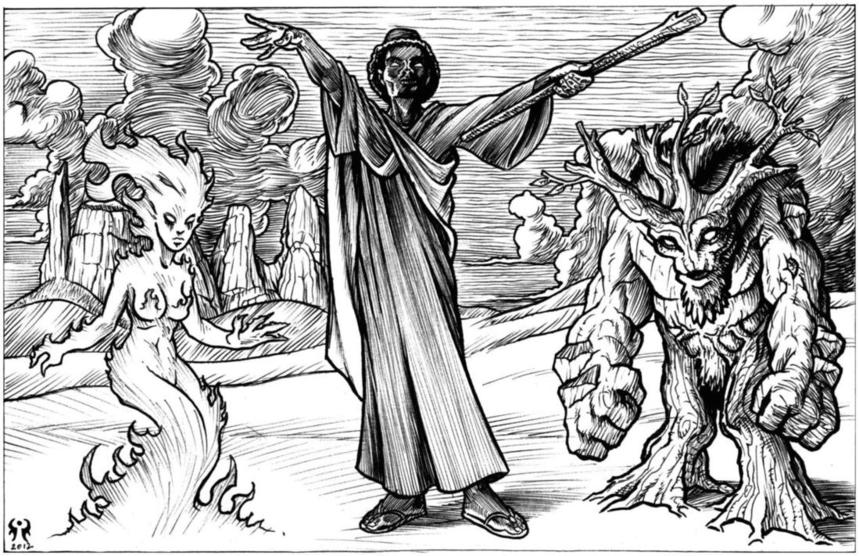
The marabout is one of the two Vancian caster classes in Spears of the Dawn. Whereas a nganga must prepare their exact spells ahead of time, a marabout can cast any spell they know within their Spheres, provided that they have remaining spell slots to use. The marabout has a greater list of effects to choose from than the griot, 40 spells total instead of 22 songs. However, there are only 5 spells per sphere, one for each level. This means that at 1st level a marabout can really only cast 2 spells, while at 9th level they can cast from a selection of 25 spells.
As mentioned before, a marabout's Spheres represent their alliances with certain spirits, with the favored sphere representing the strongest connection and bestowing them a unique Gift in addition to the spells. Marabout do not have to pray or meditate for their spells, or directly communicate with the spirits. Their favor manifests in subtle signs of approval and disapproval. Oddly enough, a marabout still retains access to spheres even if they go against the taboos and holy codes of their faith. Many scholars and theologians debate why this is: some theorize that the marabout's connection to them is too strong to break, others theorize that immoral marabout draw their power (knowingly or unknowingly) from the Gods Below.
A marabout usually must take at least one round's worth of action to cast a spell, and be able to speak to summon their spirits' aid. An enemy higher in the initiative order may hold their action to strike on the round of casting, which disrupts a marabout's spell. This action can work on ngangas as well.
So we have eight Spheres, all of them with very different effects. The kind of character your marabout can be, and their role in the party, is strongly shaped by the selection.
The sphere of Curing is straightforward, granting hit point restoration spells at 1st, 4th, and 5th level spells (the latter regenerates hit points per minute until they hit their maximum value), and curing disease and poison at 2nd and 3rd levels. As a favored sphere, it bestows immunity to all diseases. This is pretty much a good deal for any adventuring party to take, as the Medicine skill is not as immediate in its effects, and healing potions can get quite expensive over multiple purchases.
The sphere of Death grants power over the transition between life and death, the soul's passage from the mortal world of the land of spirits. Its spells involve granting the next damage roll its maximum value, speaking with the dead, taking on undead immunities and qualities, raising the dead (must be willing), and the ability to either create undead servants or damage the walking dead (both the same spell, Servants of Clay). The Gift allows the marabout to automatically stabilize when bleeding to death, and do the same to others suffering the same fate. Overall, a few of the spells are situational, but the maximum damage and resurrection are both very useful. This sphere might be good to take as an additional option later on down the line.
The sphere of Herding makes you good with animals. The spells granted allow you to speak with animals, enchant a staff with the power to scare off wild beasts, grow long savannah grass which is edible and can feed ten people per class level, transform into a beast and gain their qualities (lose spellcasting ability for duration), and the ability to summon horned warrior spirits to fight by your side. Its Gift increases the marabout's Strength or Constitution modifier by 1 point. Overall a situational and underwhelming sphere, although I can see some min-maxers incorporating the gift for some battle-priest build.
The sphere of Passion is all about manipulating the emotional state of others and getting them to do what you want. Its spells include a minor bonus on social interaction checks, have a target treat you as a trusted friend for one day per level, fill a crowd of listeners with a certain strong emotion, fill a target with grief and make them unable to perform actions, and cut a target's emotional bond with the most important thing in their life indefinitely (or until the curse is dispelled), filling them with apathy towards the subject. The Gift increases the Marabout's Charisma modifier by 1. The spells have quite long durations (even the shortest-lasting grief-based one lasts 1 round per level), which can make them very useful in games which aren't just straight dungeon-crawling. And even then they can be used to turn certain monsters into brief allies.
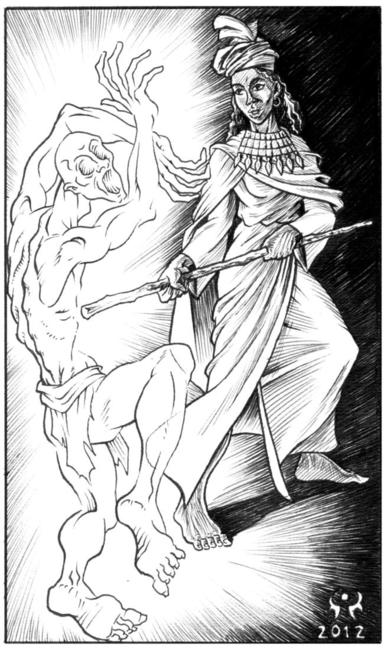
The sphere of Spirits makes the marabout skilled in dealing with the denizens of the spirit world. The spells include the creation of a spirit ward which hedges out spirits and potential possessions, a magical light which reveals the auras of magical effects and invisible creatures, a short-term suppression of curses (1 round per level), the ability to summon a spirit ally to help with tasks for 1 hour per level, and the ability to deal damage to spirits by rebuking their presence. The Gift grants the ability to speak with all spirits regardless of language barriers, +2 on social rolls with them, and the ability to see even normally invisible spirits. This is a very useful sphere all around, from levels early to late.
The sphere of Sun grants you the favor of that celestial ball of light, to channel a little bit of its great power to work your will on the world. Its spells allow you to make a ranged fire-based attack, granting you and your allies tolerance of very cold and very hot temperatures for several hours, imbuing light into a weapon to make it magical and glow and deal fire damage, a burst of light which reveals all hidden people and objects (people with Stealth skill level 3 can still hide), and the ability to conjure pillars of burning light to strike down your foes. Its Gift allows you to see perfectly regardless of lighting conditions and radiate light in a 60 foot radius at will. A very offensive-based sphere. If you're a Sun Faith marabout, you must have this as your Favored Sphere, but you gain an additional spell level per day for your devotion, so playing a Sun Faith spellcaster can be a very good choice (especially early on, when you don't have too many spells).
War governs violence and wrought iron. It is one of the best spheres for several reasons. One, its spells are relevant to a very important aspect of D&D retroclones: combat. Two: its spells are overall long-duration (3 out of 5 have 1 minute/level) and affect multiple allies (3 out of 5 affect allies within 30 foot range of the marabout). Its spells, predictably enough, grant bonuses on to-hit rolls, fill enemy opponents with fear (penalty on to-hit rolls and might flee), bonuses to armor class and reroll the damage rolls of mortal blows directed at them, the ability to restore hit points via successful attacks, and the ability to make allies share the best attack bonus of the person within their ranks. Its Gift grants a +1 on to-hit rolls with a single chosen weapon.
I haven't compared them side-by-side yet, but a War sphere marabout might just be able to fill in for a Warrior. Unlike 3rd Edition they are not so powerful as to make them feel useless, but the spells alone can buff up the marabout and their buddies to fight well in combat. The Warrior has more skills, better saving throws and hit points, but the marabout can easily get a near-equal attack bonus with buff, plus spells to boot!
The final sphere, Water, governs the streams, lakes, and oceans of the world. Spells include the ability to conjure a stream gushing out gallons of water, the ability to grant the marabout and their allies the ability to swim and breathe underwater, conjure a thick cloud of rain which hinders enemy visibility and movement, creating a snaking arc of water in mid-air which can block enemy movement and missiles (can be shaped by marabout, making it great for battlefield control), and the ability to instantly teleport themselves or a small barge across connected bodies of water. Its Gift grants the ability to swim in water as fast as they walk, and the ability to breathe in it. The early spells are very situational and not that great, but the later ones are very useful.
We also get another sphere, the sphere of Blasphemy. It available only to worshipers of the Gods Below, beings universally feared among the Three Lands for their wicked ways and fell powers. They are so named because its believed that they live deep in the bowels of the earth. Umthali (snake-people), Eternal cultists, and marabout desperate for power pledge themselves to them.
Basically, the Blasphemy sphere cannot be normally selected. Those who pledge allegiance to the Gods Below gain it as a bonus sphere, even if they're not a marabout (in this case they cast as a marabout of equal level). They must regularly perform hideous rights to please the Gods, and will be rewarded well in their afterlife. Those who seek to back out of the deal receive nightmarish visions of ghastly torment by said Gods, supposedly what awaits them in the spirit world once they die. The spells included grant the ability to summon worms to eat at the victims, force witnesses to be unable to communicate in any way about a certain action or event, manipulation and excavation of stone and earth, stunning targets by using foul curses, and summoning swarms of soul-eating worms. It doesn't have a gift, but those with this sphere gain bonuses against divinatory magic which might reveal their true nature.
As it's a free sphere, there's no downsides mechanically to taking it. However, the Gods Below are very much definitely evil people, and worshiped by those who'd be enemies of the Spears of the Dawn and most people of the Three Lands.
Nganga Sorcery
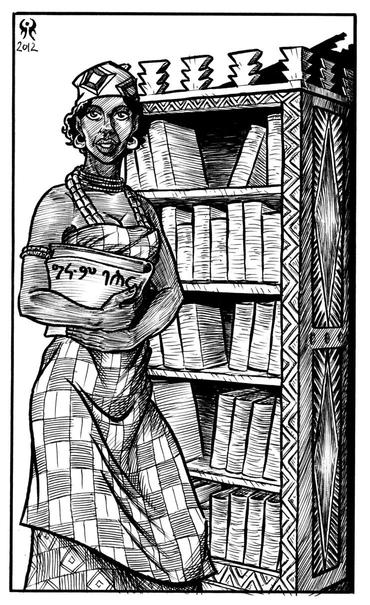
Nganga's arts and training are quite demanding. In addition to years of training under a tutor to harness their magic properly, they often must gather materials and resources to properly cast their spells, be they ritual magic components or handheld objects for nkisi spells. Most nganga are lone people of a few souls in villages, rarely attaining heights of greatness. They make their living as charm-makers and curse-breakers, mostly concerned with staying in people's good graces. The most powerful nganga live out in the wilderness, far from prying eyes to better discover the lost lore of forgotten ages. And there is the land of Lokossa, where the mightiest ngangas serve as the heads of noble families, with the mighty Ahonsu (sorcerer-king) ruling them all absolutely.
There are two kinds of spells nganga can cast: ritual spells, which face no per-day limits but have lengthy casting times and sometimes expensive material costs. And nkisi spells, more immediate magic stored in minor handheld objects upon the nganga's person.
Nganga can forage the wilderness for 10 silver ingots worth of materials per day for specific ritual spells (they can't just be gathered and stockpiled over time), while some magic requires a physical connection to a target in order to work (well-worn clothes, a lock of hair, blood, etc).
A nganga's spells per day are represented by their nkisi. They can prepare additional slots with a successful DC 6 Occult/Int roll, +2 for each additional spell. A failed roll means that all the prepared spells go off with the nganga as the target upon the completion of spell preparation. It is for this reason that most nganga do not exceed their limits except in times of greatest need.
A nganga has 48 spells, both ritual and nkisi, 5 per spell level each up to 4th level, and 4 each for 5th level spells.
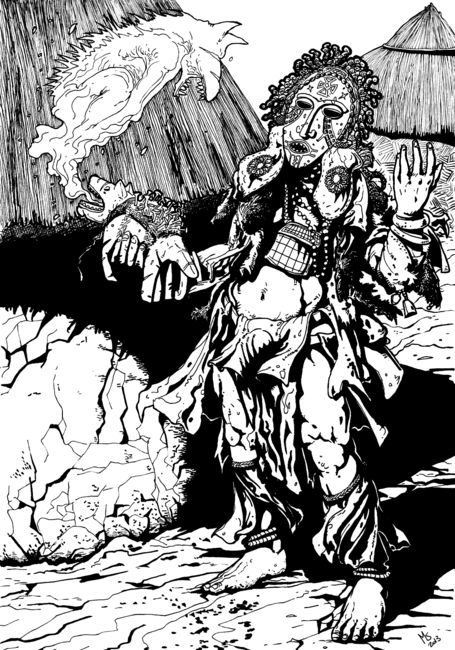
Ritual spells are quite varied in effects. Their casting times can last anywhere from 30 minutes to a whole day, and some require material costs ranging anywhere from 30 to 5,000 silver ingots. Rituals tend to be more powerful and varied than their equivalent nkisi spells, for obvious reasons, with some exceptions. Rituals can involve the lifting of curses (which have their own unique game mechanics), creating minor magic items which grant bonuses on various rolls (they usually fall apart after several uses), the ability to call forth a spirit minion or assassin for service, communicate with other people via dreams, place curses on other people which bestow penalties to certain rolls until they're lifted (or a long enough time passes), distant scrying, fast travel to distant locations by being picked up by the wind, and more!
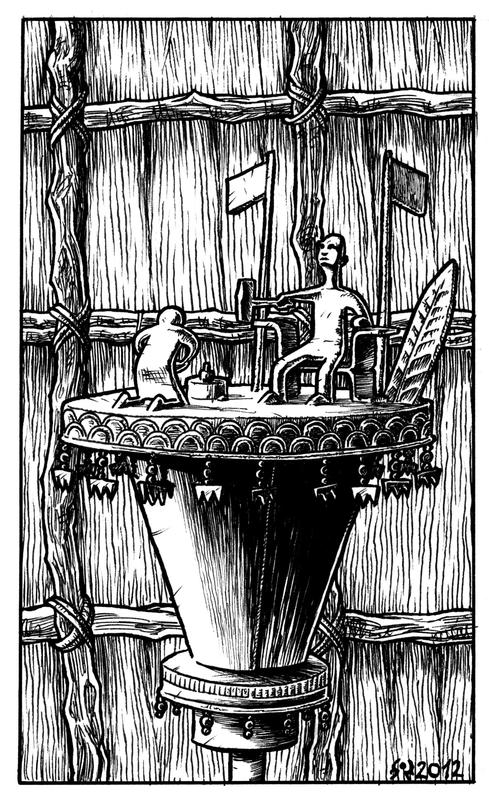
Nkisis are much more limited, but have the benefit of quick casting. Nganga nkisi tend to be more offensive-oriented in comparison to marabout spells, and some of them are quite powerful. Nkisi of the Deadened Mind, for example, is a 1st-level spell, but can turn a target into a brain-dead slave for one day per level! Granted, it's the most powerful of its level, but still. Some of the more interesting spells include Nkisi of the Broken Shadow, where a target is attacked by their own shadow; Nkisi of the Crimson Nail, which painfully pins a target to the area they're currently in; Nkisi of the Invincible Wall, which fills an ally with a short-lasting surge of overwhelming mystical force which grants a +4 bonus on their next roll; Nkisi of the Sundered Spell, which can act as a counter-dispel against enemy magic; and Nkisi of the Walker at Night, which allows the nganga to teleport between areas they're familiar with by stepping into the shadows and exiting into the place of their choice.
Ngangas are easily the most versatile in their powers, but are limited by potential costs and lengthy casting times, the necessity to prepare spells ahead as opposed to selecting which ones they want to cast at the moment, and class limitations (physical frailness combined with the inability to wear armor). The fear and apprehension they inspire in others is more of a role-playing limitation.
Thoughts So Far: I really like how the magic system interweaves with the setting as opposed to just feeling tacked on, like in the settings of other retroclones. Not only are the differences between each class explained, knowledgeable people in the game world recognize this and act accordingly. Leaders seek to stay on the good side of griots, villages turn to ngangas to lift curses, marabout can enter into new alliances with spirits over time and expand their power. Crawford put a lot of thought into this, as he did with the rest of the book's chapters.
Next time, Chapter Four: The Three Lands! Finally we get to the setting!
The First of Three Lands
Original SA post
Chapter Four, Part One: The Three Lands
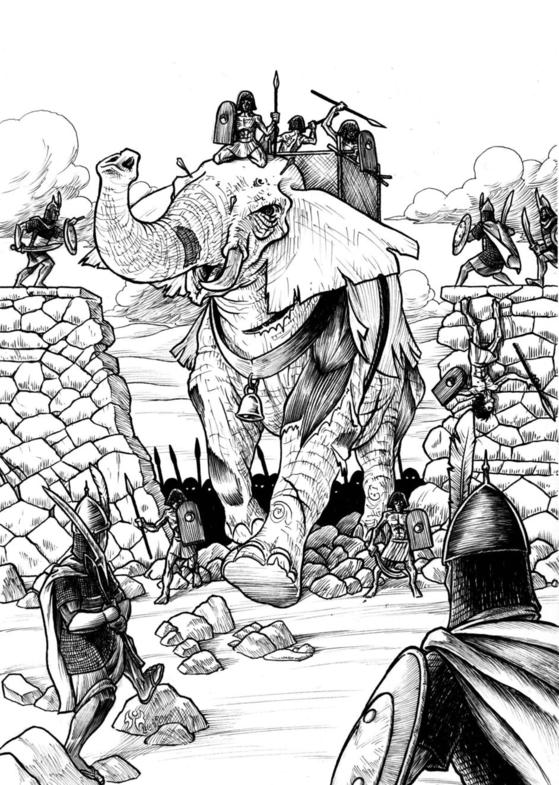
Apologies for the delay, but stuff was occupying my time. This chapter's a big one, too big for me to cover everything, so I'm going to handle it in two segments.
A Brief History
In ages past, the Old Kings ruled great nations between the western sea and the Weeping Mountains of the East. Two centuries ago the Nyala Empire waged war against the eastern kingdom of Deshur, forcing its populace to retreat eastward, into mountain temples built long before the ages of men. It was there the Deshurite King discovered the forbidden arts of the Gods Below to ensure that his people would survive and take revenge on their enemies. It was here the first Eternal were created. They were called this by the living because they never really died. They could live deep in the deserts without food or water, their flesh still and unaging with no breath of life. They lived strange pantomimes of life, only a few among their dread lords containing the skills and memories of their former lives, ruled by a dread Eternal King.
They ventured west, bringing the Three Lands into a conflict called the Long War, so named because it lasted 150 years. Only the internal quarrels among the Eternal and the need to hold onto existing territory did they not conquer the Five Kingdoms. Even some among the living began to worship the Eternal as new gods, forming cults and secret societies motivated by the promises of power and immortality.
Forty years before the current era did Emperor Kaday of Nyala realize that the Five Kingdoms must be united if they were to drive back the Eternal. He formed a binding alliance with independent and former Nyalan provinces of Sokone and Kirsi by promising them autonomy, earning their soldiers yet angering the Nyalan nobles who lost their traditional holdings. But it worked, for they led a unified army into the east which even the Eternal could not hold out against. Emperor Kaday strode alongside the Sorcerer-King of Lokossa at his left, and the greatest Marabout sages of the Meru on his right. Before him rode the iron lancers or Kirsi, and at their flanks marched the sea-wide legions of Sokone with the best equipment and training their gold could buy. They stormed the walls of Desheret, the capital, and the Emperor died in battle against the Eternal King, who was wounded and taken to recover deep into the Weeping Mountains.
The Long War was finally over, the soldiers returned to their homes. But the Eternal still lingered, in hidden wilderness tomb-houses and supported by loyal cultists. The Spears of the Dawn were formed among the best soldiers of all the nations to hunt down these remnants, promised freedom, gold, and other privileges as long as they performed their duty. Nowadays the Spears have little official support, eventually becoming but a tradition upheld by individual teachers.
The Eternal and the Spears
We get short blurbs further detailing the Eternal and the Spears of the Dawn. Basically Eternal are mortal spirits trapped in their own dead bodies, losing most of their reasoning and mental faculties save for a few powerful individuals. They are hierarchal, being ruled by former nobles and spellcasters among them. Despite the benefits of undeath, all Eternal cannot heal naturally, and must regularly consume living human flesh to avoid further desiccation. Secondly, they're all driven a hatred of all living things which can only be held in check with sufficient willpower. Thirdly, and most horribly, they can never know the peace of true death. Even if hacked apart and stomped into a bloody paste, their minds will still continue on in a red haze of never-ending confusion and agony. Their spirits will always remain in this world, never moving on.
The Spears of the Dawn were formed by Emperor Kaday and an alliance of the Five Kingdom's best soldiers. In exchange for venturing out and destroying the Eternal remnants in the time of tenuous peace, they'd be promised riches and land once their mission was finally done. In the meantime, lesser nobles would show deference and respect to Spears and do their work without interference. The Emperor died before he could fulfill his promise, and the governments never bothered to give them land, but the Spears remained true to their cause. Cleaning out Eternal tombhouses was dangerous, but they could earn a comfortable living selling their plunder, and it was preferable than stealing from peasants or fighting one's fellow man. Over time they expanded their efforts beyond the Eternal, defending the common folk from all manner of beasts, bandits, and other dangers of recent years.
Spears of the Dawn are exempt from the lesser laws of the Five Kingdoms. They can get away with more troublemaking and minor violence than any commoner, and are not expected to conform to the traditions of their gender or social class. Said tolerance has its limits, as theft, murder, treason, and major crimes will be punished, but a Spear who can demonstrate and justify his or her actions can stay the wrath of a noble.
Life in the Three Lands
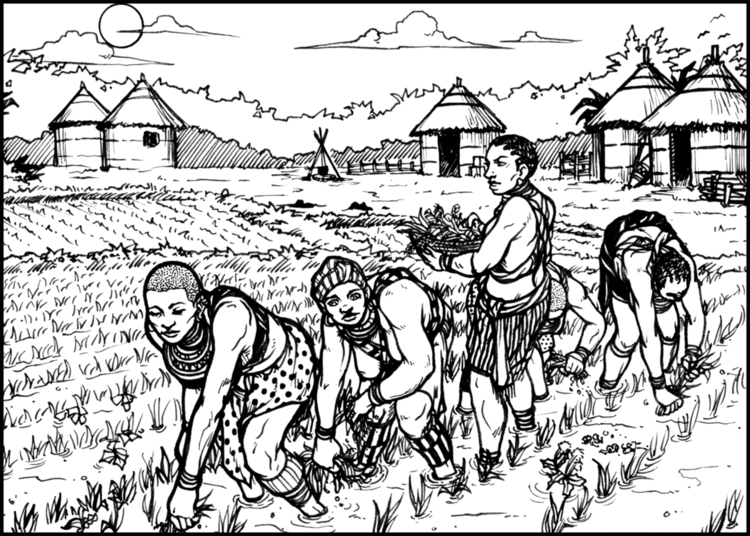
Although each kingdom has its own culture, traditions, and history, there are some general trends which can be applied broadly. The setting is divided into five kingdoms discussed in the first chapter, along with three general geographic regions known as the Three Lands: the Green Land, the Yellow Land, and the Black Land.
All of the Lands are hot in climate. The Green Land is in the west, comprising the meadows and forests of Nyala, the marshes and fields of Western Sokone, and the rainforest of Lokossa. The Yellow Land is much drier, comprised of the golden grass savannas of the Meru and the hills and badlands of Kirsi. The Black Land of the east is nearly impossible for humans to live in, so named for its ebony sands. Only among the banks of the Iteru River can living settlements survive. Eventually the sands give way to dark, craggy hill and the Weeping Mountains.
Basically, life in the Three Lands is feudal to one degree or another. Society is hierarchal, where those in power (be they nobles, ngangas, merchant families, or tribal elders) are in charge of overseeing the affairs of the majority, protecting them in exchange for service. Society is structured in that every person is expected to perform their role for the betterment of the community, and that trying to defy or escape this fate is selfish and puts everyone else in jeopardy. Even the Spears, who are regarded as remarkable people, are burdened with the tasks of defending the rest from the Eternal and other horrors. And while minor nobles might live lives of privilege, they must at least tend to their duties if they expect to hold onto their land and titles from rival groups and heads of state which in turn rule over them. In short, everyone must do their part.
The Three Lands place a high importance on politeness, even between different social classes. A Lokossan noble might "ask" the serfs when the harvesting of rice will be complete rather than ordering them into the fields, while the courts of Nyala are an elaborate web of "gifts" and "favors" where people ask and demand things in roundabout ways which might be imperceptible to outsiders. People who can't get along with their neighbors might eventually find themselves exempt from the laws and social contract of their town and village, and be forced to leave or fend for themselves. Overt rudeness is tolerated between close friends and family, because only kinsmen would speak so coarsely about each other. Rudeness between strangers and enemies, however, puts people at alarm, for it's usually a precursor to violence and when words can no longer settle disputes.
The author says that the DM should cut the plays some slack in the portrayal of their characters. Don't punish them for using modern protocals, and take their in-character words in the spirit that they're given rather than how they're conveyed. Fostering immersion in the setting is better accomplished by focusing on the NPCs and how to present them in the proper light. This is good advice!
In regards to family and marriage, relationships are expressed in terms of nations, clans, and families. Nations began as tribes which conquered or assimilated with their neighbors, until they reached a large-enough population and area that society transforms into the concept of the nation-state. There are some ethnic minorities and cultural holdovers which first and foremost refer to their tribe or clan, but most people identify primarily as being part of one of the Five Kingdoms.
Clans are more important at the local level, generally being shared descent from a famous figure, spirit, or important historical event. Clanmates are expected to provide food and shelter to each within reason, knowing that they would do the same for them. As a survival mechanism it encourages the richer members and farmers with good harvests to help their neighbors survive in hard times.
Gender and Sexual Orientation
Society is overall patriarchal. Men inhabit most positions of power, from governance to military to other important and prestigious decisions, and the eldest males of the families are in charge of being the "priest" for appeasing local and ancestral spirits (or the Sun in the case of the Sun Faith). Marriage is determined by a man paying a bride price to the woman's family, and polygamy is common among society's elite of both the Sun Faith and Spirit Way religions. Divorce is permitted, and although it's officially initiated by the man, poor treatment and abuse of a wife can be grounds for it. The offending husband in this case is often jeered by villagers for wasting his wealth and being a jerk. Adultery is a fair reason for dissolving marriages, with custody of the children usually going to the wronged party.
In regards to sexual orientation, it is regarded as something people do and not a part of a person's identity. Even people who exclusively prefer partners of the same sex are expected to marry the other gender and raise a family, with discreet same-sex relations being overlooked as long as they can provide for their spouse and children. Homosexual and bisexual people are not seen as monstrous or evil, rather they're viewed as excessively lustful. Same-sex activity is not illegal, but on the other hand they are not recognized as valid marriages.
Despite having sexist and homophobic elements, there is a degree of social change going on in the Five Kingdoms. The Long War drained many males into military service, forcing woman members of the community to step in to fill now-empty occupations. Spears might be exempt from societal expectations and regarded as strange people, but heroic and virtuous men and women can serve as an example to others and cause people to reconsider their old traditions and preconceptions. Even Lokossa has some concessions in regards to sexual orientation and gender; men and women who perform roles traditionally regarded for the other gender can be socially and legally considered that gender from then on out.
This isn't unique in Crawford's work. He often has sexist and homophobic elements in his campaign books, enough to provide conflict for groups who want it but not so restrictive that being anything other than a straight male is a constant obstacle. Instead of having things be hopelessly regressive, PCs can help change things for the better, and being Spears can exempt them from the traditional restrictions of society.
I think that this is an overall good way of doing it, although I still think that such things should be wholly decided by the group. Players who deal regularly enough with sexism and homophobia in their real lives might not want it intruding into their escapist fantasy.
Crime and Punishment
We get some blurbs on crime and punishment. Basically, most lands once and currently governed by the Nyala Empire have their legal codes descended from the old laws, with some degree of change between local ordinances. Petty crimes such as theft, insulting a noble, and drunk and disorderly are punished with small fines and a few blows of the rod, with greater crimes such as destruction of property might result in financial reparation or private beatings (public beatings are deemed harsher due to the humiliating aspect). Capital punishment is reserved for the most heinous of crimes, such as murder, rape, and the destruction of holy places (an intentional and violent insult to the community's spirits).
Slavery is considered barbaric and illegal everywhere except Lokossa, where it's reserved for criminals and social malcontents. It used to be a widespread practice in the days of the Old Kings, but the Long War forced all hands to fight for survival until it led to a near-total diminishment of the practice. The depletion of people at the end of the Long War has put an increased demand on labor, and disreputable people powerful enough to operate beyond the reach of the law have dragooned people into workshops, timber camps, and vast farms. Slavers are technically kidnappers and criminals, and the slaves are chosen among people who have few people to care for their fate (the exiled, criminals, foreigners, etc). However, they are hated by the authorities even if they can't do much to stop them, and heroes and Spears who put a violent stop to their operations are almost never legally prosecuted for this.
Food and Drink
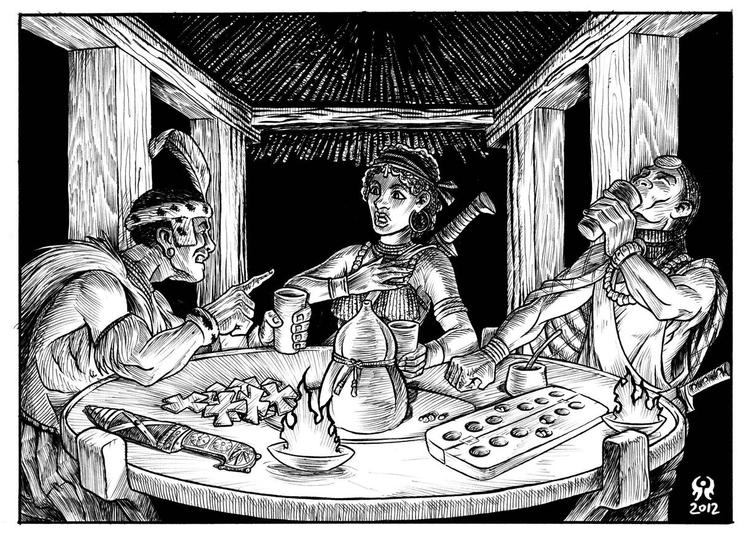
*note the Mancala board game in the lower right.
The most popular food and drink in the Three Lands are wheat, maize, rice, water, and alcohol. The three grains are prevalent in the lands of Kiris, Sokone, and Nyala, with wheat and corn most prevalent in the north. Taxes are usually paid in grain. The Meru's entire diet revolves around their herd of cattle: meat, milk, blood, and entrails are usually eaten raw in honor of their ancestors who were too busy fleeing the Eternal to set up cookfires. Cooked food is tolerated, to an extent, more for women than men as it's seen as "unmanly." Lokossa's staple food is the cassava, the woody root of a shrub grown in clearings which must be carefully prepared, for eating it raw can cause permanent nerve damage due to being laced with cyanide in its natural state.
Water, wine, and fruit drinks are the most popular drinks of choice. Palm wine is favored in the Green Land, while beer is more popular among the well-to-do. Fruit drinks are distilled from bananas, mangoes, melons, plantains, coconuts, dates, and whatever else can be found (grapes are unknown). The Meru have no known alcoholic beverages.
Thoughts so far: I like the overall setting, and how Crawford gives just enough for DMs and players to get a good view without bogging them down in minutiae and lore. We get a good grasp of how daily life is conducted on the local level, which is a plus. The second part of this chapter's review will discuss Religion in the Three Lands, along with individual write-ups of each of the Five Kingdoms.
The Second of Three Lands
Original SA post
Chapter Four, Part Two: The Three Lands
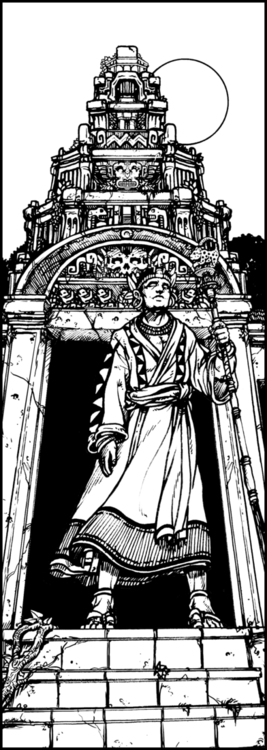
Religion in the Three Lands
The Three Lands are very religious, and honor the spirits and the Sun with great devotion. People are faithful because they hope it will provide them with protection and an ease of hardship, both in this world and the next. And given the obvious presence of supernatural entities and practitioners who do reward and punish people, this is not just a "take it on my word" deal and one rooted in actual observances.
The cosmology of the setting is ordered into two spheres, the mundane, material world and the spirit world where gods and ancestors live. The spirit world is just like its physical counterpart, only more extreme in both the good and the bad. Spirits in general are vaguely aware of actions in the material realm, and expect their rightful due from mortals in the form of offerings and worship. Wrathful spirits can blight crops, cause misfortune, and place curses on people. However, spirits who are pleased with mortals can grant them boons and watch over their communities as protectors. It is the responsibility of the eldest male of a household to act as a "priest," or one knowledgeable in the proper rituals and ways of appeasing the spirits, although in the last two generations more and more women have adopted this role.
For followers of the Sun Faith, they believe that beyond the spirit world lies the Burning Heavens, a happy realm of light and truth the true faithful go to as their just reward. A few of the sternest believers do not even offer sacrifices to the spirits, viewing the Sun as the only one worthy of this. Many Sun Faith practitioners in Kirsi still perform private rites to the spirits out of tradition and fear.
There are two kinds of worship among both faiths. Household worship of personal shrines for the Spirit Way and sermons of the Sun Faith, and communal worship where the entire town engages in dance, song, and prayer as an elaborate ceremony. These communal rituals are an elaborate and expensive affair, and often reserved for holidays.
Temples and shrines are very common among Spirit Way devotees, with even the crudest village having a special area set aside for veneration. Temples in general are meant to serve to honor spirits in general, and often have their own images and decorations to be swapped when it's time to honor a different spirit or set of spirits. It's a rare or prosperous community which can afford its own shrine for a single popular spirit. The centers of worship in Nyala are particularly grand, although in the wake of the Long War many such places fell to ruin or were converted into Eternal strongholds or claimed by bandits and monsters.
When the kingdom of Deshur still stood, its people worshiped a pantheon of beast-headed spirits, and it is also where the Sun Faith originated (and whose people were driven out west). Now the traditional Deshurite religion is not practiced anymore, the Eternal possessed of intelligence owing allegiance to the Gods Below.
The Sun Faith does not really have temples as such or make sacrifices, believing that material objects and livestock are an unimportant and ultimately needless way of showing one's faith. Instead, they have prayer-houses. Sun Teachers are religious scholars tasked with memorizing the Four Corners of the Mountain, the original lessons penned by the Sun Prophet. The Kirsi have prayer-houses ranging from huge, beautiful shrines to serviceable buildings, while the Meru merely hold their lessons orally in the open air.
Generally speaking, the Spirit Way is most predominant in Nyala and Lokossa, while the Sun Faith is the norm among the Kirsi and Meru. Sokone is home to both practitioners, although the priests there are more syncretic and tend to have a "the gods and spirits only care if you honor them properly, whoever they may be" attitude.
Popular Gods and Spirits
The true number of spirits worshiped is uncountable. Every province has its own gods, although there are a few sufficiently popular and powerful spirits whose influence reaches far. Even then they have their own regional faiths under different names and qualities.
The Ancestors are the backbone of the Spirit Way, made up of the souls of former mortals and respected in household shrines. Aganyu is a god of fire, famous for his anger but also a protector of children and the powerless. The Gods Below are wicked entities whose very names are poisonous to the soul, and were the ones who taught the Deshurite King the secrets of the Eternal. Gu is the god of iron and war, who soldiers and blacksmiths turn to for success. Olokun is a goddess of water and wisdom who favors female priests and marabout. Oya, the Tearer of the Veil, is the patron of storms, wind, and travelers, her aid often asked for to guide the newly-dead on their journey to the afterlife. Sagbata is the punisher of the wicked, afflicting smallpox and madness to evil folk, although his high standards often hurt innocent people as well. His priests strive to calm him down so that he punishes only the truly deserving. The Sun is a great spirit which hangs in the sky and the favored patron of the Sun Faith. Sun Teachers claim that all other spirits are but servants to his glory. Oko is the father of crops and the earth, a calm and reasonable god favored for his judgments and placated by farmers. Oshun is the goddess of beauty, passion, and eloquence. She is adept at settling disputes and inspiring lovers and artists. Merchants favor her to gain blessings in future business deals.
Priests
The concept of priests exists, but is largely locally-centered and without a chain of command: there is no "Spirit Pope" or Sun church branches or anything resembling a huge national organization setting down official doctrines and laws. Instead, priests are the technicians of the spirit world, trained in the proper rituals, expectations, and words of the gods; the vast majority aren't spellcasters, their training coming from the Priestcraft skill. Most communities expect priests to be just, moral folk, although their prime duties aren't to serve as moral exemplars. Priests who behave wrongly can be stripped of their position if they break one of the Sun or the spirits' taboos. Larger temples tend to court marabouts of the appropriate faith to provide blessings, leaving the day-to-day temple duties to those without magic. This can create quite a bit of jealously between the magically barren priests and the gifted marabouts, who wish that they had such favor with the spirits themselves.
Funeral Customs
The afterlife is the passing of a mortal soul into the spirit realm, where they join their fellow ancestors and sometimes non-human spirits who they were loyal to in life. This journey is no small feat, for proper funerary protocol is necessary to ensure that the spirit has proper help and guidance and does not return to the material world as a suffering ghost. To die alone and unburied is a horrifying fate to pretty much everyone. The minimum effort requires the washing of the body, laying it in a dignified position, and appropriate prayers and well wishes. A proper funeral involves the entire community, sacrifices to the gods for favor, and a great meal and rituals tended over by trained priests. The Sun Faithful replace material sacrifices with more prayer. The stronger and more elaborate the rites, the more aid the spirit gets on their journey.
Peasants and commoners are usually too poor for such a funeral, and instead rely on a secret society of funerary adepts who practice powerful magic to make up for the lack of resources. Such societies are relatively common knowledge, but the actual list of members and their rites are guarded jealously. Unfortunately the nature of such societies proves a prime method of dark cults and criminals to conduct their operations while still maintaining good publicity.
The Spirit World
As to the spirit world itself, the spirits live the same way as much they did in life, conducting the same business and dwelling in the same place. They do not grow and change as people do, with no ambition to move beyond their roles, and the strife of living societies is pretty much unknown among them. Kings and queens sit in their palaces issuing no commands, merchants trade goods but don't care about becoming rich; every soul tries to replicate their "proper role," and can become upset and worried when they're thrust outside of it. Ancestors who receive no sacrifices, prayers, or even remembrance grow upset, feeling alone and ignored and disrespected. Sacrifices done well can bring succor and happiness to a spirit, and the best rituals can even elevate their station and power. Some spirits have found their way into the material world, whether as typical incorporeal ghosts and flesh-and-blood entities, and most of them tend to be evil entities. Spirits who seek to do good can do so from their own world, or when summoned by a marabout or nganga. By the same token, mortals are not welcome in the spirit world, and only the mightiest of them can hope to travel safely in these realms.
Spirits who are "slain" in the material world are shunted back to the spirit world, inflicting pain and confusion which can last for years. Every 'death' strips away more of their memories and sense of self until they are little more than beasts of mindless rage. It is said that the mightiest gods know of ways to erase a spirit from existence entirely, but this power is rarely if ever used. Even the wickedest spirits are mostly confined to the darkest and most isolated pockets beneath the spirit world's earth.
Concepts of virtue and sin are generally tied to cultural customs and the decrees of the gods. There is no "universal" set of rules, for each culture has its own ways, each set of spirits their own taboos. Even worshipers of wicked entities such as the Gods Below will be rewarded by their patrons for their loyalty, even if mortal society hunts them down and exiles them from their communities. As a general rule both the spirits and the Sun encourage honesty in word and deed, being loyal to one's family and clan, obedience to tradition, and kindness to the weak.
The Five Kingdoms
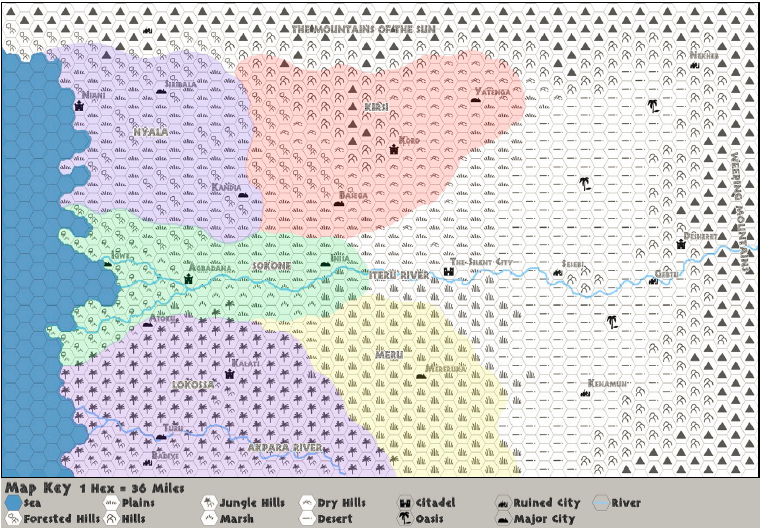
The Five Kingdoms used to be mighty centers of civilization, with the mighty Nyala Empire and the sorcerer-kings of Lokossa ruling vast stretches of territory. The Long War saw poltical split-offs and divisions, along with entire provinces being put to the sword and torch by Eternal wrath. Areas once home to bustling towns are now silent and claimed by the ravages of the wilderness. It has been seven generations since the nation's armies were strong enough to extract their dues, and the more remote regions saw the rise of petty nobles and warlords taking advantage of their newfound freedoms. In general, each kingdom is ruled by a monarch of some sort, who has a court of advisers beneath him. Outlying towns are ruled by obas, or "lesser kings," who are either appointed by the monarch or the patriarch of the city's foremost noble family. Smaller villages do not usually have obas, instead being ruled by a chief.
Settlements listed on the map above are the largest settlements, the capital cities at least 50,000 people and the lesser cities of around 10-30,000. The Sokone seat of government, Agbadana, is home to a many 100,000 souls. The cities of the Three Lands are old centers of civilization, built upon the mounds of previous settlements which form a sort of "under-city" home to the secrets of ages past and disreputable folk and monsters to avoid the gazes of those above.
The villages of fewer souls are innumerable and often passed over by the larger governments save when its time to pay taxes. Such places are more prone to raiders and monsters and being taken over by petty tyrants. As the ill-equipped village militias do not have the resources to continually push back such threats, they seek the assistance of traveling Spears of the Dawn.
Kirsi
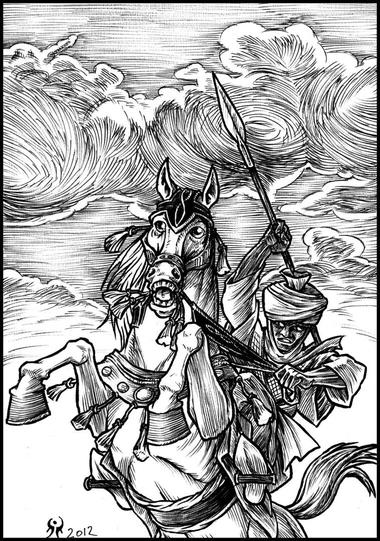
The nation of Kirsi is a land of warm hills and badlands. Its people number among the finest horsemen of the Three Lands, and they have a long history of war: first it was with the Deshurite neighbors of the east back when they were a province of the Nyalan Empire. Then it was with the Eternal and Nyala during the years of the Long War. When they weren't united against a greater threat their noble houses fought among each other for all variety of reasons.
Even before Nyala's legions reached the land, the Kirsi were a mighty neighbor who would not be conquered easily. A well-armed populace and the superior mobility of their cavalry meant that the Nyalans used diplomacy and trade instead. This worked, and the Kirsi houses swore fealty to the Empire. In exchange for the might of her soldiers, the Kirsi were paid with many riches and respect, and the old palaces still standing are relics of this era.
When the Long War came, the Kirsi paid a dear price to shield their land and Nyala from the undead, and Nyala's legions was repulsed from the Black Land. The Empire promised to come back and defend them when they were ready. They were never ready, and in anger the Kirsi declared independence, and Nyala turned its own soldiers on the "rebel provinces" as much as they did the Eternal.
Today, Kirsi is its own nation. The clans of the country are free to govern themselves as they see fit. The Dia of Koro is said to rule Kirsi in its entirety, but the reach of his law is as only as far as his lancers can ride. He must threaten, bribe, and negotiate with the clans to get them to work together, and only then in times of dire need. Otherwise, the feuding clan-lords keep up a regular flow of deniable incidents of raiding and skirmishing with their enemies and annexing each other's territory. What makes them different than bandits is that they don't steal from their kindred or those who haven't wronged them, in theory. In practice, many less scrupulous noble houses can extort more than their fair share of taxes from small villages under their "protection."
Kirsi culture is very clan-focused, much more so than the other four nations. Every family knows their relations of ancestry or lack thereof to their neighbors, and every adult male can trace a line of command in relation to their kin. Glory and good deeds are also of great importance, attained through success in their roles and their ability to inspire others to follow them in example. Even a poor course of action by a warrior can be forgiven if performed with sufficient dedication and zeal. To not give it your all, or to fail a task because of laziness or neglect is shameful. The Sun Faith made serious inroads among the Kirsi, replacing the centuries-old practice of ancestor and spirit worship. The first Meru missionaries earned their respect for their persistence against the Eternal and the miracles of their marabout.
The Sun Faith's emphasis on protecting the weak has tempered the Kirsi lust for glory. Many men and women who tired to the feuding nobles and clan strife strove to serve a higher purpose and protect the innocent, and formed the first Sunriders. This order of pious warriors owes no allegiance to the Dia or any Kirsi clan, instead honoring each other and the Sun Faith. They are popular among the common folk, although the more corrupt magnates and many of the clan-lords hate them but don't move against them openly...yet.
Kirsi who number among the Spears of the Dawn tend to be warriors, from veterans of border raids, homeless peasant soldiers displaced by fighting, noble horse riders, to idealistic Sunriders. Griots are the next most common class, inspired by the examples of their ancestors, and marabout of the Sun Faith. Ngangas are rare, as there are few mentors in the country to teach them.
The Kirsi are very dark-skinned, their features stern and hawkish from the arid winds. Men and women alike tend to be slender, their hair long and black. Men tend to braid their hair, while women wear it long and decorate it with accessories if they can afford it. Outer clothing for both sexes tends to gear towards light-colored turbans and robes split for riding. Brightly-colored tunics are favored for more casual wear. Kirsi warriors are also known to wear armor, with heavy Kirsi mail favored by mounted lancers, with footmen quilted layers of cotton or leather armor.
Lokossa
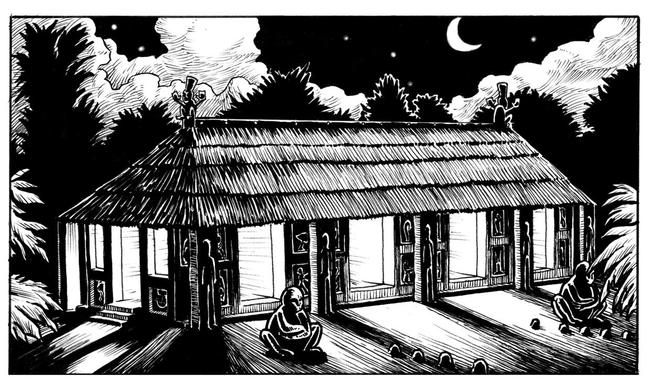
Lokossa is the southernmost nation of the Three Lands, claiming much of the rainforest. The only realm to never be claimed by the Nyala Empire in an official capacity, a long-running dynasty of ngangas gives the place a sinister reputation among its neighbors. Lokossa is a harsh realm, its jungles home to many dangerous creatures and perils, and the teeming hordes of monstrous Night Men to the south of the Akpara River have been raiding the nation ever before the oldest legends and records of its griots.
Lokossa's noble families all bear that quality necessary for one to learn the manipulation of ashe, and point to this as physical evidence of their right to rule. They wed only among each other and sufficiently adept sorcerers to avoid diluting their bloodline. The Ahonsu, or Sorcerer-King, is the most powerful of these nganga, and is always succeeded by another, even one of another family. His word is law when he lives, but can be overturned by future rulers once he dies and his corpse joins the others in the tomb-palace. It is by their great magic and rituals that they can hold back the tide of Night Men, who would certainly overwhelm Lokossa and possibly other northern nations were it not for their constant vigilance and sacrifice. Powered by the blood of executed slaves and criminals, the Ahonsu and the nobles can wield magic unseen among the other kingdoms. This, and how they spend their people's lives like water in this war, causes others to fear the Lokossans, but the people of the nation view this as a necessary sacrifice, not just for them, but for all the Three Lands. Were it not for them, they say, the ruins of the southernmost jungles would extend all the way to Nyala.
Lokossan society can pretty much be summed up as "tyrannical magocracy." Society is harshly regimented, most villages comprised of nuclear families cut from the all-encompassing jungle ruled over by a noble family. The gulf between the haves and have-nots is a world apart: commoners are servants of the nobles, sometimes even slaves, and their rule is absolute. There is no appealing to a higher authority for abuses of power, and even freeman can only hope to flee and live in another village. Sometimes nobles who go too far inspire village rebellions, although they are loath to admit to the existence of these, both to avoid being seen as weak, and to avoid giving thoughts of discontent to other villages.
Commoners who display magical talent are adopted into a noble family, with even marabouts inducted into noble priestly societies who honor the spirits of past Ahonsu.
Nobles still must pay their dues. In addition to collecting taxes and tribute for the Ahonsu, they are expected to serve the government for life. Noble men who have no talent for sorcery must train as warriors, women as administrators and scribes. Noble spellcasters serve as priestly support and magical aides, and all of them are officers at the front of armies whenever the Night Man invade again, or conduct costly and elaborate rituals for war.
Lokossans tend to be rather short in comparison to the people of other kingdoms, and have very dark skin. Both men and women cut their curled hair close to the skull, with only noble women growing long, decorated braids. Clothing varies by social class and circumstance: laborers wear little more than woven skirts and loincloths, the women breast-bands. At home both genders have waist wraps, the men a brightly-colored sash, the women counter-patterned scarves draped over their shoulders. Noble warriors wear warding amulets and aggressively practical clothes, often no more than a waist wrap.
Lokossa is a patriarchal society, and their idea of who is a man or a woman is often as much based upon behavior and occupation as biology. The continual press of the Night Men has forced the military to train women warriors, and those who serve in the army for a living often gain legal recognition as men. Lagredi, men who adopt "womanly" professions, are often taken as wives by noblemen and some possess knowledge of herbal remedies and rituals to assume the social and physical roles or women. Polygamy is common among noblemen to ensure the survival of their bloodline.
Lokossans who number among the Spears of the Dawn tend to be people who have left their homeland. Criminals, commoners who earned a noble family's anger, and escaped slaves are the most common.
Meru
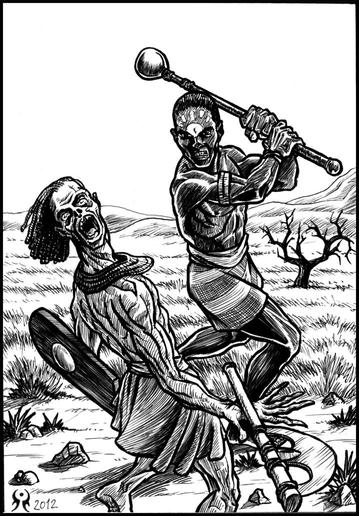
When the Eternal King killed the Sun Prophet and made worshp of the Gods Below mandatory, not all were willing to listen. Some numbered among the faithful of the Sun, others people too disgusted to accept the "gifts" of the Eternal. They were chased beyond Deshur and into the western savannas, where they joined and intermarried among the indigenous tribes of the plains to stay ahead of the undead armies. For as long as the Sixth Kingdom existed the Meru had no peace, forced to continually move as nomads. They spent several generations leading their herds ahead of the vicious Eternal thirsting for blood and vengeance. They proved invaluable to the other kingdoms when they united against old Deshur: the wisdom of their olabons (ngangas) knew of the many safe spots of the desert, their warriors born and raised to kill the Eternal and know no fear against them. Ever since the Long War ended, the Meru have kept to their ways that they knew for so long.
The Meru are technologically primitive in comparison to the other people of the Three Lands. They do not have written records nor do they rely upon coins as currency, instead using cattle and livestock for barter. Their settlements are mobile, comprised of leather tents and those few settled ones living in thatched mud huts behind walls of kraal. Society is ordered around the extended family, traced paternally. Each family belongs to a specific "city," a legacy of Deshur for when refugees from the same cities banded together. The five remaining city-clans are Jenu, Waret, Akor, Medjed, and Jayet. There is a sixth "Written City" which all olabons are considered to belong to regardless of their original clan. They all maintain their own general boundaries to roam over in the plains, and the others are expected to respect these borders.
Leaders among the Meru are chosen by the male heirs of noble lineages who are chosen by the clan. Patriarchs can determine pasturage and other important negotiations, and those who don't follow their duties can find their positions replaced. The Meru do not practice capital punishment, instead exiling criminals of such heinous crimes out into the wilderness to fend for themselves.
In recent decades the Meru's numbers have grown with the retreat of the Eternal, taxing the resources of the savanna. The need for pasturage and water sources creates no small amount of grief and tension between clans. Increased incidents of cattle rustling and quick drives into claimed pastures to be used for a time are increasing in frequency. At its worst, some families have begun fighting in earnest. The griots and marabouts try to keep such pressures to a minimum, but things are growing worse. The Jenu and Akor have even been making claims on Sokone and Lokossa lands, which is sure to bring violent reprisals.
The Meru are the lightest-skinned people of the Three Lands, tending towards a deep coppery complexion. Older men and olabons shave their head as part of a custom, but adult men generally wear their hair in long braids. Those containing stronger lineages of indigenous blood have much darker skin tones. Meru are very tall, and dress in the leather wraps of slain cattle, and don't wear shoes, viewing them as signs of a bad runner.
Meru are very patriarchal, women expected to be docile wives and homemakers. In light of the growing population pressure, women who chafe at these restrictions are encourage to seek their fortunes elsewhere. "Remarkable women" who display exceptional martial or spiritual talent, or who bring great wealth and fame to the family name, are afforded the same rights as men and have their pick of husbands eager to seek such an exceptional woman as a wife.
Meru are a natural fit for candidates as Spears of the Dawn, due to being raised on a legacy of resistance towards the Eternal. Warriors are skilled with the traditional siare throwing clubs and runku war staves, and shun bladed weapons as signs of ill omen, for they are suited to killing one's fellow men rather than Eternal. Griots serve as negotiators on behalf of a city-clan, and the best-trusted are ones who traveled farthest beyond their traditional lands. Almost all marabout are faithful teachers of the Sun Faith, and priestesses are often exempt from the traditional restrictions placed upon their gender. Many have an almost-missionary zeal to spread their faith to outsiders. Nganga among the Meru are known as olabons, taught the secrets of ancient Deshur by their mentors. Membership among the olabon is decided by signs and portents demonstrating proficiency with ashe.
Thoughts so far: This part's getting a little long, so I'll cover the final two countries in the next part. I really like how much detail has been put into the setting, and the details on religion are a big plus. I do like the versatility between the various nations, who all have their own flair and flavor.
The Third Land
Original SA post
Chapter Four, Part Three: The Three Lands
Nyala
The Empire's too glorious to be contained in an image, making it the only country in the book to not have one.
Nyala is an ancient country now on the decline after the Long War. Its earliest records five hundred years ago described it as a rustic pastoral nation regularly troubled by giants who lived in the Mountains of the Sun to the north. Despite them being twice as tall as the humans, Nyala's warrior fiercely fought to protect their homes, impressing the giants who offered a non-aggression pact. Over time relationships between the two peoples became peaceful, and the Nyalans learned of many advanced technologies from their taller neighbors to strengthen their nation. Silk, sculptures, metalworking, and advanced stonemasonry made the cities beautiful, its soldiers finely equipped. Flush with success the Nyalans expanded southwards, and thus began their golden age.
Four hundred years ago the giants retreated back into their palaces deep in the mountains for unknown reasons, breaking their pact and refusing to answer calls and summons. Despite their departure many Nyalans, especially the nobles, bore giantish blood, its most common manifestations brightly-colored tattoos and red, white, and yellow hair.
Nyala drove east and south, claiming the lands of Kirsi and Sokone and ruling over the people. They even claimed Meru, although the nomads moved so fast and so often the Nyalan legions could not really tax or subject them to their laws. The only kingdoms unconquered were Lokossa, whose sorcerer nobles and rainforest terrain made the country a human meatgrinder for Nyalan soldiers, and the kingdom of Deshur, whose people were forced eastward by war. Emperor Shangmay would not be content until he ruled the whole of the Three Lands, and pushed the Deshurites east across the deserts and to the point of grim desperation. The pharaoh of Deshur found secrets in the forbidden temples of the Weeping Mountains, and used it to create the first Eternal and begin the Long War.
And thus began modern history and the slow death of Nyala as an empire. Provinces were lost, Kirsi and Sokone declared autonomy, Emperor Kaday fell in battle in battle against the Eternal King (although some theorize that it was Nyalan steel that betrayed him for forsaking territory in exchange for international cooperation). Now the remnants of Nyala's nobles are either "Hollow Princes" left without territory or squabbling over the scraps of land remaining, and Kaday's son Issay abandoned the title of Emperor in exchange for King, little more than a figurehead now controlled by feuding lords and ladies who'd rather have him on the throne than an enemy clan.
Nyalans as a people are aware of rank and status. The nobility is fluid, where a family is considered such under the laws of the Mai's court, but clans unable to defend their territory or wear the trappings of wealth and luxury will result in the rejection of their peers who bar them from the court. In the old days only the Emperor could strip a family of nobility, but now this has fallen in favor of social agreement among the clans.
Nyalan commoners are largely laborers who seek to make the best lot in life amidst burdening taxes. A commoner can seek social increase by wedding a noble (if a woman), or being skilled in swordplay or artistry. Nyalans in particular have a fondness for beauty in all its forms, and talent in one of these areas can earn patronage from influential clans.
Nyalans are tall and slim, with skin the color of dark mahogany. Those with giant blood could end up with jewel-colored eyes, patterned tattoos, and bright hair colors, mostly among the nobility. Clothing for commoners consists of trousers and tunics, dyed with colorful patterns. Nobles prefer flowing robes of brocaded cloth with many gauze-light layers. Nyala is the only country with native silk, and it is improper for the affluent to wear clothes of any other material.
Most Nyalan adventurers are such out of necessity or ambition, depending on their station. "Excess" scions are expected to find their fortune in far-off lands, and griots are known to search for relics of their nation to bring back and glorify. Marabouts tend to leave the Spirit Way temples uneasy and encouraged to go elsewhere if they can't cooperate with the high priests. Ngangas are rare but mentors can be found deep in the wilderness or scholars in the great cities. Warriors are common due to Nyala's legions, although any "remarkable common folk" can display the talent of an idahun.
Sokone
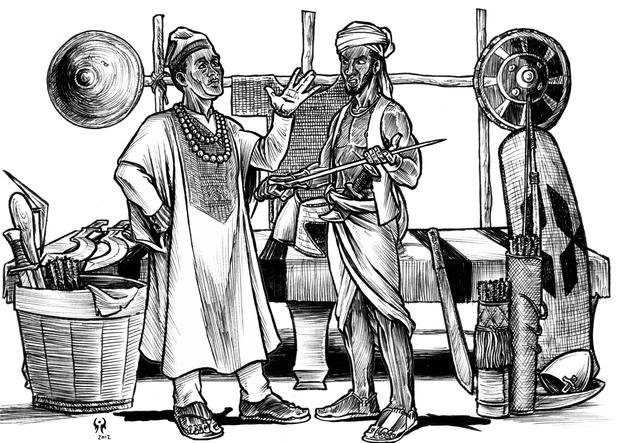
The Sokone live among the valleys and bogs of the mighty Iteru River, a cosmopolitan land of traders and wealth unseen since the kingdom of Deshur or the old days of Nyala. Descendants of tribes pushed south by Nyala and refugees from Lokossa, shared hardship brought the two peoples together in mutual aid. Its merchant background is due in part to the swampy terrain: tribes lucky enough to attain some prime rice fields had to constantly guard it from hungrier neighbors, forcing the lesser clans to resort to trade in natural resources from the marsh's bounty and ingots mined bog-iron. As they needed all the armed men they could against two hostile neighbors, internal disputes between the Sokone became based on trade and negotiations.
Even then there was war within their lands. The city-state of Umthalu to the east was ruled by serpent folk wielding powerful dark magic who felt threatened by Sokone's expanding influence. They were no match for their monstrous magic, and so the merchant-princes struck a deal with Nyala to protect them from the snake-men. Between the two nations they drove the Umthalu out of their cities and slaughtered nearly to the last person. The Umthalu city of Chakari became Sokone's new capital, the strange magic glyphs covered over by new walls.
Sokone society today is a plutocracy. Every family has its enterprise or trade, whether it's growing rice, smelting, or the merchant-princes who manage half their city's financial affairs and businesses. Those who hoard their wealth and do not use it are regarded as worse than beggars, for they refuse to take advantage of the gifts provided to them and their family. As such many families are driven to destitution when they spend too much on frivolous novelties. Gift-giving carries an additional layer of complexity, for it implies a sign of obedience and acquiescence to the taker.
Where nationality and ethnicity are strongly tied together elsewhere in the Three Lands, the Sokone are a cosmopolitan people drawing upon ancestry of all the others. The physical features and traits of Nyalan nobles, Meru outcasts, escaped Lokossan slaves, and several hundred smaller tribes now long-vanished can be found. Their clothing is just as varied, a mixing of styles from robes to loincloths to tunics and wraps.
Sokone adventurers tend to be those with no interest in their clan's business or life as a merchant, instead seeking quick riches through dangerous work. Marabouts are found both among the Spirit Way and Sun Faith, its ngangas are just as likely to be cosmpolitan as rustic folk, and their griots are particularly daring when it comes to exploring dangerous places. The country does not have the famous martial traditions of Kirsi or Lokossa, but its wealth means that their warriors are well-equipped.
Thoughts so far: And thus ends Chapter Four. I don't really have much to add, other than this one as a whole is one of my favorites in the book. It's a detailed overview of the lands and their people without detailing every small settlement or lists of notable NPCs.
Next time, Chapter Five: Running a Campaign.
Running a Campaign
Original SA post
Chapter Five: Running a Campaign
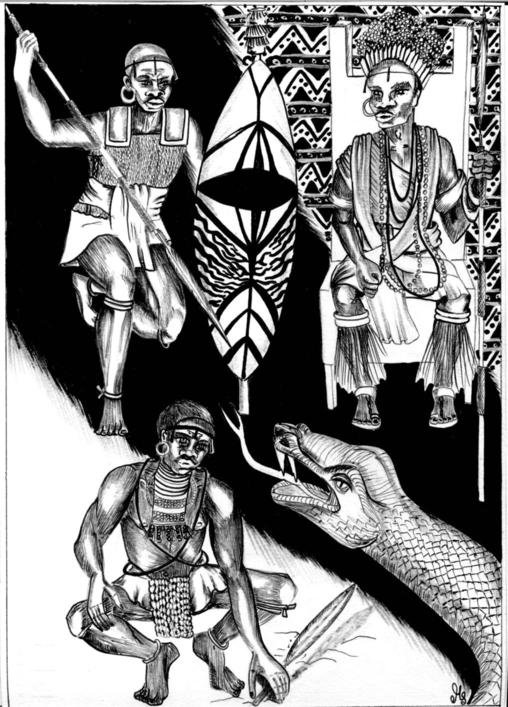
Spears of the Dawn, along with other Sine Nomine products, favors the sandbox model of gaming. Basically, this style of play places the PCs into a fictional world, the GM describes things and offers some plot hooks and suggestions, and the PCs are pretty much free to go where they want and do what they do. To use a video game example, it's a lot like The Elder Scrolls Oblivision or Skyrim in presenting a dynamic open world to explore and pursue the adventures which interest you. It is PC centric, focused on the things which are important to them. In a sandbox game there are no plot-essential NPCs, no adherence to a particular story arc or events which must happen or items which must be claimed.
Although such sessions break a lot of common assumptions and can be hard for the Game Master to plan, but the author's got you covered with some good advice and a bunch of charts and tables to generate everything, from adventure plots to locations to monsters to NPCs! Only the adventure chart's present in this chapter, the others found later in their own section.
Crawford suggests that the players have certain responsibilities in a sandbox game. Chiefly, their PCs need goals, for the entire game is predicated on the assumption that they want to achieve something substantial and not just live uneventful lives in a village. Backstories and goals have no guarantee of plot armor or resolving the way the players want; in a sandbox game, anyone can die, and the GM is under no obligation to design certain dungeons and regions in line with the average party level. Crawford insists that having certain areas be more dangerous than the others, along with the lack of "plot armor," forces the PCs to think critically instead of assuming that the GM will save their skin.
The GM has responsibilities, too. PCs need opportunities to pursue their goals, doubly so in a campaign setting which will be unfamiliar at first most players. Giving the group something to work with at the start can make the open-world Fantasy Africa seem less daunting. Secondly, the PCs' actions should be logical and consistent with the world. If the PCs choose not to deal with an evil sorcerer attacking a village known for its bountiful rice supply, then the bad guy will take control of the place and increase the prices of food in nearby provinces. If the PCs avert an assassination attempt on a Kirsi clan-lord, then they will gain the gratitude and favors of that clan.
Additionally, the GM must be ready to anticipate PC actions. If the group decides that trekking south to Lokossa for aid against an Eternal army is a better course of action than beseeching Sokone merchant-princes, then a sketch of some rainforest terrain and potential inhabitants and locations should be in order. That way you can have the necessary material for the next game session.
quote:
The golden rule of sandbox content creation is simple- if you don’t need it for the next session, or you’re not having fun creating it, then don’t bother with it. You don’t need to do it. A game that leaves you drained and exhausted is a game that’s certain to fail. Running a sandbox is meant to be fun for the GM too, and you shouldn’t force yourself to do preparation work that isn’t satisfying or entertaining for you.
Setting Up the Campaign
Before a sandbox game must start, Crawford says that you must decide on how to introduce things to the PCs. First, decide whether or not to use the Domain Rules found later in this chapter. Basically they're a mini-game simulation of major troubles in the Five Kingdoms and their reactions with each other. Secondly, find a starting point. Crawford recommends a small market town on the frontier of civilization, which are more likely to contain bandit strongholds, Eternal tombhouses, hidden cults and traditional fantasy adventuring stuff. Thirdly, a starting adventure with an obvious and compelling hook; this adventure needs something to unite the PCs together as a group and get familiar with the setting.
After that, the GM should present adventure hooks and see what elements of the setting fascinate them most. Instead of consulting the book for minor details, the GM should make something up, write it down, and make sure it stays consistent throughout the sessions. This cuts down on making sure that things are canonical and saves time on flipping through the book. Keep quick reference sheets on hand, and at the end of every game session write down a short summary of events and ask the players what they want/plan to attempt the next session. That way you not only have a good way to memorize what happened last session one or two weeks ago, you also have a platform from which to work on for future sessions.
Crawford heavily advises against detailing everything about a campaign world, in that it can lead quickly to GM burnout and most of the material won't be immediately useful in actual gameplay.
Challenges
There are common issues Crawford talks about in Spears of the Dawn, and how to handle them.
The first is combat. This RPG, along with many other OSR games, is quite lethal at low levels. A 1st-level PC can very easily fall to a well-placed blow. Players of games where combat is less lethal or they have a metagame resource to save their bacon might have trouble adopting to this. Crawford has a few suggestions. One is to have players make "back-up" PCs to enter the story shortly after a PC's death as soon as possible. Another is to grant 10 bonus hit points. That, and making sure that the group is on the same page regarding mortality.
Otherwise Crawford suggests the GM to remember the reaction and morale rules. Not all monsters or miscreants will want to fight to the death, or enter into battle unless they have a very good reason for it. Do not make combat inescapable at low levels, allow the PCs to be able to retreat from a fight.
Second is investigation and environment interaction. Whereas many OSR GMs operate on a "player skill is character skill" for non-combat stuff, Crawford takes a different approach. On the one hand, he says that players who describe PCs interacting with the environment should find hidden objects there in lieu of a perception roll. However, he mentions that PCs possess knowledge of skills and abilities the players don't have in real life, and that demonstrations of such skills should be abstracted. Just as a player doesn't need to describe how he sutures shut the wound of a companion, so does it mean that a smooth-tongued griot PC shouldn't take a penalty on social rolls because his player has a stuttering problem in real life. On the other hand, the PC's choice of approach before committing a skill roll should alter the difficulty a little in one direction or the other.
Finally, there should always be a way forward in investigation-focused encounters. Players confronted with a dead end will resort to desperate and foolish measures.
Loot and Wealth
Spears of the Dawn does not operate on a standard magic item shop economy. While spellcasters can sell minor trinkets, more powerful magic items are inhabited by great and powerful spirits (in this setting, most magic items are home to a spirit). Said spirits will take offence if they feel that their owner is devaluing their true potential, such as selling a sword wielded by the first Nyalan Emperor for 1,000 silver ingots worth of rice. Even the inviting of selling it will bring a parade of messengers to the PCs, many of them untrustworthy and eager to cheat the party out of it, where more power-hungry folk will try to force the party to part with their fabled treasure.
Powerful magic items should be the result of adventuring, rewarded as gifts for virtuous deeds, and the like. Magic item spirits have no problem being given "freely" to an owner who proved their worth.
Instead, rich PCs can spend their money on land, recruit followers, acquire goods and favors, and invest it into the community. A manor is both more useful and harder to steal than tens of thousands of trade ingots sitting in the party's wagons, and the gratitude of a community or ruler can grant a wide assortment of benefits and favors to PCs.
Setting Unfamiliarity
Most table-top gamers in the English-speaking world are most immediately familiar with European myths and folklore. We generally have a good idea of what a knight is what they usually do in stories, just like how when we hear the description of a bearded old man with a magic staff we think "wizard!" The fiction of Africa is just as rich and rife with awesome role-playing potential for games, but most of us don't even have a basic knowledge of what life in medieval Africa was like, much less their centuries' worth of cultural traditions and folklore. To deal with this unfamiliarity, Crawford offers three bits of advice: cliche, translation, and agreement.
First, cliches are ways of making sense of complex situations. Instead of getting players to understand the subtleties of the Long War or the founding of the Spears of the Dawn. All they need to know is that they belong to an elite order of wandering troubleshooters with a knack for delving into undead and monster-filled ruins and tombs and saving the common folk from bad guys. Not only is this a familiar concept to most pseudo-Europe D&D games, it's a simple way of illustrating to the players about core elements of the setting. Likewise the PCs don't need to know about how Lokossa's social system was formed as a result of constant warfare against the Night Men; all they need to know is that this nation is a tyrannical magocracy.
At this point I notice that Crawford begins repeating himself, as I see some bits of advice from earlier chapters.
Second is translation, or responding to the intent of the PCs' social interactions rather than implementation. If a PC tries to accomplish something which may seem inappropriate, adjust the outcome in line with the lifetime's worth of cultural knowledge said PC possesses. Even then, Spears are nearly expected to have a disdain for traditional customs and the niceties of society. As long as the PC isn't intentionally trying to piss off an NPC in-character, let their intent trump tactless approaches ("How's it hanging, Sorcerer-King?").
Thirdly, agreement is a task to make the players more familiar with a very foreign culture more amenable. Basically, agree with the assumptions that the players might make about the settings. Unless it's important to contradict them or will cause significant problems down the road, allow their guesses to be more or less accurate. Every time the GM pauses to say "no, that's not what the book says," or elaborates on some bit of backstory, this pushes the players farther from their comfort zones with the world, discouraging them from acting fluently within the setting. Naturally, players will players will start making comparisons of setting tropes to familiar material, or "fantasy feudal pseudo-Europe" onto the Three Lands, and that if you don't want this to happen to sketch out relationships as part of the game session before it becomes an issue.
Finally, the Three Lands are a different setting with different values than most tabletop fantasy games. Women have less rights than men, warfare is considered glorious (actually, I don't see this as that different myself than most D&D games), same-sex relations are neither totally accepted no demonized, and society's rulers are generally considered to be of more inherent worth than commoners (once again, not much different than fantasy pseudo-Europe). Players who don't like these values can change them; even in a land where one's station in life is considered the "way of things," people still want for the good things: they want peace, they want safety, they want protection from the monsters beyond the fire, and Spears who can grant them this gain the trust of a community who will be more willing to listen to their advice. Instead of the GM portraying the setting as gritty grimdark or hopelessly regressive, he should make it clear that the PCs do have the power to do something about it. It might not be easy, and it will take a lot of work, but the possibility is always there.
Overal I like the advice. I particularly enjoy his suggestions on easing the players into an unfamiliar cultural counterpart, and his compromise between "player skill" of OSR games and abstracting the results of skill rolls, where most OSR designers and products go entirely for the former.
Running the Five Kingdoms
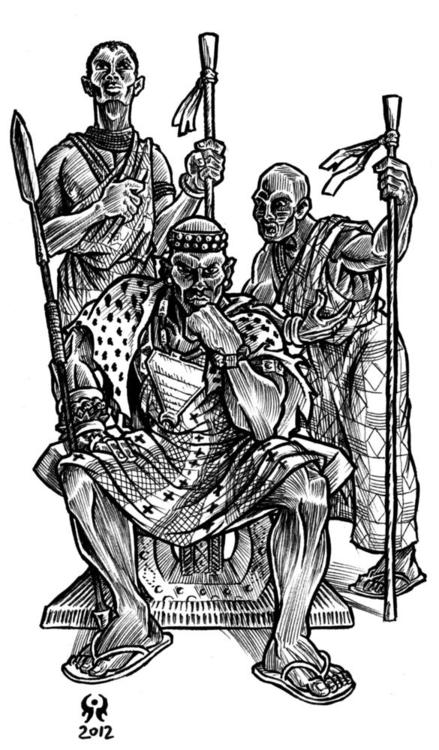
This section's a toolbox for GMs to build a more solid foundation for campaigns which progress beyond the local level. It's part conflict resolution engine, part adventure seed generator, and part political maneuvering tracker. The tools fashion diplomatic goals and relationships between the kingdoms to create a dynamic world and adventure plots to tempt your players.
Basically, there are 3 stats to track kingdoms: Might, Troubles, and Treasure.
Might is a 1-5 scale (1 for a village, 3 for a province, 4 for a nation and 5 for vast empires) of a place to determine its ability to attack hostile outside forces, keep law and order, and its general power and resources. A Might contest is a 1d6+Might roll with the higher result winning, and a tie going to the one with the higher Might.
Trouble is a score which reflects disasters and strife afflicting a community. Each individual trouble has its own score, with higher values of greater magnitude. For example, "Popular uprising in the west" may be a 4, witchcraft activity 2 in a village might be 2, while the "Eternal of the Silent City uniting against our nation" can be a whopping 15! Each kingdom by default starts with 1d6+6 points of trouble, and PCs might be able to resolve or minimize these troubles as the result of adventuring. Each settlement can only handle a maximum Trouble value before collapsing into death or anarchy, determined by their Might. A mere Might 1 village collapses at 6 Trouble, where a Might 4 kingdoms collapses at 20 Trouble.
Treasure represents not only trade ingots but its ability to mobilize peasants, stock of natural resources, and economic power. Treasure points can be spent to add to a Might or Trouble check to represent the government investing resources in dealing with a problem. A state cannot spend more Treasure than their Might rating, however. Some actions require Treasure to undertake at all, and don't add their bonus to the roll. Generally speaking Treasure scores cannot be measure in ingot value, but PCs who donate wealth to a cause or tax their lands might need a good estimation. Generally speaking, 1 Treasure Point represents 100 silver for a Might 1 village, 1,000 for Might 2 town, 10,000 for a Might 3 province and so on.
At the start of a campaign each kingdom has a Role which determines starting values and proper actions. An Ascendant kingdom is undergoing an era of prosperity and starts with more Treasure and less trouble. A Declining kingdom starts with no Treasure and 1d6+12 Trouble. A Hostile kingdom has a bitter enmity to one of its neighbors, and will prioritize actions towards harming said neighbor even at the cost of their own well-being. A Fractured kingdom represents a full-blown civil war or rebellion on a nation-wide scale, and must roll Trouble checks before acting or else it must spend its turn dealing with their own internal conflict (which is a Trouble all its own). An Exhausted kingdom is tired of the outside world and turned in on itself, not seeking entanglements with other nation except in self-defense.
One of the Five Kingdoms is a Traitor, its leaders secretly made a deal with the Eternal in hopes of immortality and power. Their treachery is well-concealed, for it would cause the other four kingdoms to turn on them. Said kingdom has an interest in plundering Deshurite strongholds and Eternal tomb-houses to obtain the forbidden lore. If the Traitor gains 25 Treasure earned from Purify actions, then they assemble the requisite lore and can control the Eternal, which is a Might 3 ally all its own and can take its own actions every turn (although they're solely offensive) against the other kingdoms.
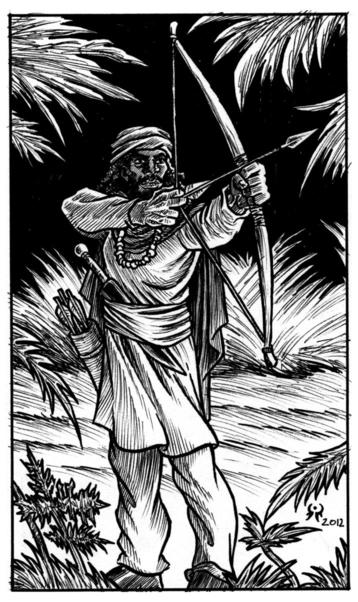
Every kingdom can take an action of its own during its turn. Generally they cover the likeliest actions, and if the GM needs something not covered on the list they're encouraged to use a Trouble check for internal matters and Might for external conflicts. Generally they're performed for things the PCs aren't involved in. If the PCs help restore a trade route by clearing the area of monsters, which would ordinarily be a "Trouble 3" event, then the action is automatically resolved with no Might check necessary.
I won't cover all the actions here, but they're obvious things like Attack (wage war), Expand (add new Might over a reasonable period on success, Trouble if failed), Purify (clean out Eternal strongholds, gain Treasure if successful, trouble if failed), Trade (both states roll Trouble checks to gain 2 points of Treasure each), and the like.
I feel that this mini-game would be too complicated to introduce to a first campaign, and it tends to involve things which do not directly involve the PCs. I also feel that certain kingdoms are inappropriate for Roles. I can't see the Meru turning Traitor, whereas Ascendant for Nyala would contradict the in-setting description of an Empire in decline.
We end this chapter with a table of Action and Trouble examples, which can be generated by rolling a D12, twice in the case of Troubles. They're rather open-ended and serve as good adventure fodder. For example, a result on the Purification table has dangerous books of Deshurite magic being sought out by good and evil folk, while a sample Trouble has unearthed ruins sending out awakened monsters.
Thoughts so far: Although a short chapter, this has a lot of interesting advice not ordinarily seen in most RPG books.
Next time, Chapter 6: Creating Adventures
Creating Adventures
Original SA postHey everybody, guess who's back?

That's right, everybody's favorite fantasy Africa retroclone!
Chapter Six: Creating Adventures
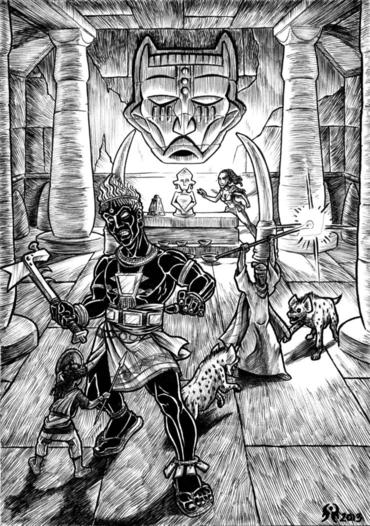
The following chapter is half generic advice for adventures in a sandbox environment, half randomly-generated locations and characters to create quick adventure hooks for the campaign.
The first bit of advice tells the GM to talk with his players on what kind of adventures excite them. If dungeon-delving into tomb-houses is the big draw to the game, then feature that. If they want to rebel against a tyrannical oba and be heroes of the common folk, then provide adventure hooks in line with this model. As a sandbox mode of adventure means that the players can easily go wherever and the story moves with them, the GM should also ask at the end of each session "okay, what are you planning on doing next?" As this is different than the traditional GM-led method of plot, players unused to this freedom can be eased into it by providing them with a list of adventure options at first.
The next session discusses three aspects of an adventure: the set, or location. The actors, or NPCs. And the props, or objects important to the adventure, including but not limited to treasure and magical items.
For the set, the author advises to make a rough map of the area (where hand-drawn or taking a sample from the back of the book), keying areas deemed important, and not sweat the details on empty or uninteresting areas. He suggests that no more than 25% of a dungeon be full of such rooms; everything else should have some neat feature, detail, actor, or prop. We also get a full-page spread of tables containing Features of Interest. Take for example the trap table:
1d12 The trap is...
1 Pit trap, 1d3 x 10 feet deep
2 Poisoned needles dart from a piece of furniture
3 Arrows shoot from behind an awning
4 A stone block falls from the ceiling
5 Blade drops from above or swings out from wall
6 Walls that compress the luckless intruder
7 Alarm that summons nearby foes
8 Door closes and locks 1d6 minutes after entering
9 Footsteps press down on a bellows of poison gas
10 Valuable object is the pin that sets off the trap
11 Crude tripwire that releases spiked branch
12 Magical effect triggered by simple touch
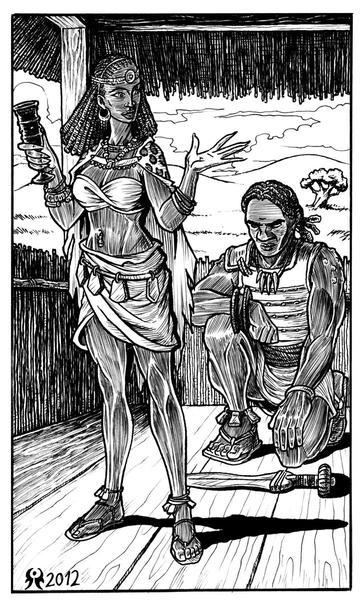
Actors are NPCs who have a motivation in the adventure more complicated than "guard treasure, kill intruders."
quote:
Actors are different. They have a motivation or goal that is likely to intersect with the players, and they aren’t simply reactive denizens that respond only after being provoked. The witch-lord of Lost Badiye doesn’t just sit on his royal stool and wait for heroes to come stab him, he’s trying to whip the unruly denizens of the ruined jungle city into a military force capable of breaking the Lokossan border guards and opening the way for his Night Man allies. He’s going to be taking actions appropriate to that goal, and if the PCs start slaughtering his potential cannon fodder, he’s going to be inclined to do something about it.
In the terms of exploration-based adventures, such actors might approach or interact with the PCs in regards to their ultimate goals. In regards to antagonists inhabiting dungeons, it's inevitable that they will not be content to wait about in Room 5 for a band of adventurers to bust in. Intrigue-based adventures are the most complication of all, and need a major source of conflict between the actors which can change and react to the PCs' interference.
Props, simply put, are objects which are important or attractive to the PCs. Traditionally they can be money and treasure earned through completing quests, but can also be a MacGuffin or sought-after relic which can only be activated after some great task. In regards to loot, the author advises that not all treasure in the dungeon be accessed through combat; if every treasure must be pried from the cold dead hands or claws of an enemy, then this will teach the PCs that the only worthwhile way to get rich is to kill people. Options to bypass combat via stealth or mobility, or finding a hidden room full of relics by solving a puzzle, add variety. On the other hand, treasure which can be useful in combat is likely to be within easy reach of the owner.
Finally, Crawford asks three questions for the adventure's final touches. Is this adventure easily accessible to the PCs? Is it a railroad? Does it take into account the PCs' prior actions? In regards to these questions, he recommends that the adventure's plot should be something the PCs would plausibly follow, that the adventure factored in the possibility of the PCs just quitting (via a backup plan like an unrelated dungeon to explore outside the adventure's location), and that adventures should have at least a callback to past acts of heroism and infamy by the PCs to make them feel that their actions have an impact on the world around them.
Awarding Experience
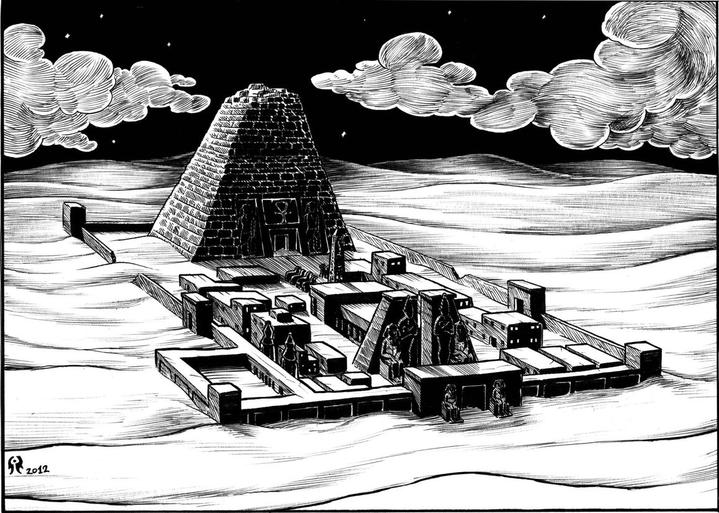
A picture of the Silent City, according to the TIF image's filename in the Art Pack.
Spears of the Dawn uses the traditional experience point system of old-school D&D retroclones, but it departs from it in some major ways.
All PCs use the same experience progression chart, and they gain experience at the end of every game session. Crawford has a table of suggested experience for session based upon level, which works out by RAW by 1 level every 2 game sessions from 1st to 9th level, then 4 game sessions 9th to 10th level. Killing monsters and acquiring treasure is not baked into the system; instead, PCs gain experience points for at least trying to do something risky and meaningful. Legendary heroes slaughtering petty bandits with no greater ambition will not advance.
Crawford suggests adjusting experience rewards to speed up or slow down leveling, as well as the option for quest-based experience rewards as an incentive for the PCs. He also brings up the old-school D&D model of spent money granting experience, but this will require less randomness and more micro-managing of treasure unless he's ready for the possibility of unpredictable character growth.
The second half of the chapter has 11 One-Page Templates. The Templates are a collection of related tables to generate content on short notice. They range from locations such as ruined dwellings and urban palaces (with the tables being room features, common guardians and inhabitants, types of treasure, conflicts and troubles in the area, etc) to organizations such as crime syndicates and wicked cults. The tables work really well, and a simple tossing of a few d12s can tell you a lot about the area.
Let's say the GM needs quick details of a Forgotten Shrine. He rolls 4d12, and gets a 3, a 10, a 4, and a 9.
For Shrine Guardians and Perils, we learn that a loose spirit-beast which was worshiped by the inhabitants is now prowling the ruin (3).
For Valuables, there is golden finery of the high priest's wives (10).
For Interesting Shrine Inhabitants, we have the sole survivor of a former adventuring party (4).
For Traits of the Shrine's Faith, it's the last-standing monument to a once-popular and prominent religion (9).
For organizations and people, the tables are more background and relationship-based.
Thoughts so far: The advice is rather generic, but the idea of awarding experience independent of killing monsters and talking with the group on what kind of adventures they're interested in a novel departure from many D&D tropes. It helps keep Spears of the Dawn fresh in the OSR scene, and the tables are quite useful as well.
Next time Chapter 8: A Bestiary of the Three Lands
A Bestiary of the Three Lands
Original SA post
Chapter Seven: A Bestiary of the Three Lands
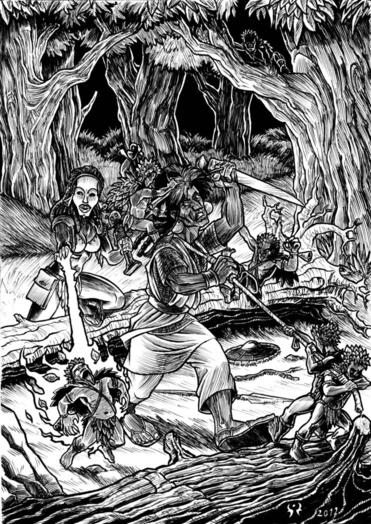
This is the section of the book detailing not just sample monsters, but rules to create your own adversaries and creatures for campaigns. Like many OSR games, monsters and NPCs abide by different rules than PCs. While they share common traits such as hit points and hit dice, Armor Class, and attack and damage modifiers, they have a more simplified way of doing things. All NPCs and monsters roll d8 for hit dice (the lack of bonus hit points for Consitution is balanced out by the d8); they have a singular Save category which applies to all saving throw-related effects instead of 5 different ones. They have a skill single modifier (ranging from +1 to +4) which applies to things the creature would be skilled at. Finally, we have a Morale ranging from 5-12. A 2d6 is rolled whenever the monster suffers fear effects, the tide of battle turns against them, or similar things; a lower result than the score causes the monster to flee or rout. Naturally, some monsters have Morale 12 (fearless fanatics, mindless creatues, etc) and fight to the death.
And finally, monsters and NPCs might have unique abilities, or limited or even full spellcasting potential.
For example, here's a stat block for the Eloko:
quote:
1 Eloko: AC 6, Move 20’, HD 3, Atk +5/1d6x2 claws, Save 14+,
Morale 8, Skill +2, bells chime as a Nkisi of the Deadened Mind
Short, sweet, simple.
The following page has three sample tables for creating new creatures. The first table divides game stats into rows based upon the monster's role: a Fast Chaser might have a 60' movement (twice as fast as a normal human)and 4 Hit Dice, while a Brutish Meat Slab might have only 20' but 7 Hit Dice. The second and third tables determine typical behavior in combat (loves false retreats, panicked by fire or magic, etc) and special abilities (Leadership grants +2 to attack and morale to allies, etc), both determined by a d20 roll. Of course, you can choose an appropriate feature instead (and the book tells you this).
I really like this monster creation method; the math values for hit dice, saves, etc is in line with the rest of the manual, so it should be consistent.
Creatures of the Three Lands
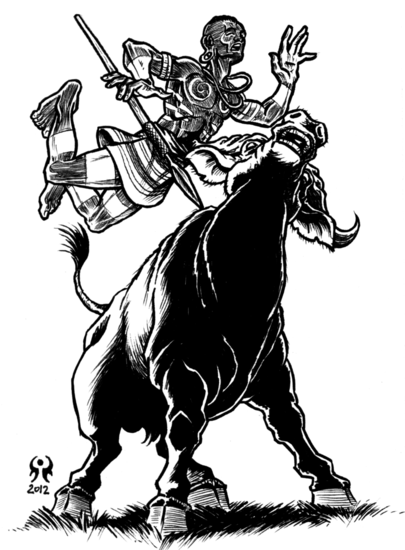
There are 26 separate entries for monsters and human NPCs in this section, not including variants under the same general entry (such as vipers and pythons which have their own stat blocks under "Snake"). In addition to mundane animals, the bestiary borrows heavily from African folklore instead of rehashing common D&D creatures.
As there are so many creatures, I'm going to give one or sentences for descriptions instead of repeating all their stuff.
Buffalo are strong herd animals of the Yellow Lands. They are incredibly aggressive and will work together to rescue injured and captured herdmates.
Crocodiles hunt among the rivers of the Three Lands. Although known to gather in groups, they rarely work together to bring down prey.
Eloko are 3-feet tall cannibal dwarves with a burning hatred for humanity and love to feast on the flesh of women. They wear bells around their necks which can mesmerize victims with their ringing. Grass grows from their bodies instead of hair, and their nails are long and sharp.
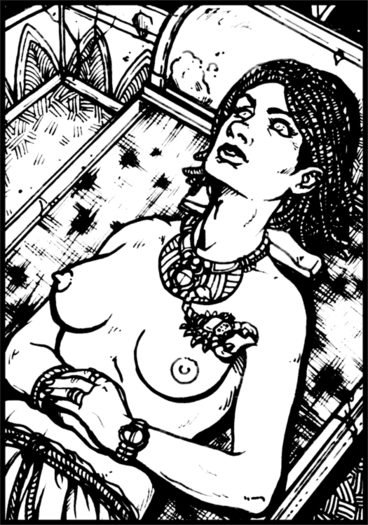
Eternal are the undead survivors of the Sixth Kingdom of Deshur, although they turned many others to an undead state with the spread of their atrocities. The majority of Eternals are but Dreamers barely aware of the world around them, commanded by Nobles and Lords who retain all the skills and intelligence they had in life. It's easy enough to create a Dreamer, but turning a corpse into a Noble or Lord requires very expensive rituals of occult knowledge and relics (10,000 for a Noble, 25,000-50,000 for a Lord and ranks in Occult).
Fanged Apes appear much like their peaceful gorilla counterparts, except with an oversized set of sharp teeth and an eagerness to use clubs and thrown stones as weapons. They love to hunt humans and their favored targets are children, and are most common in the jungles of Lokossa; a few hill-based variants lair in the crags of Kirsi.
Ghosts are incorporeal spirits and undead who are tethered to a limited area in the material world. They are usually the result of a poorly-planned burial or an extreme unwillingness to accept death.
Giants are the tall inhabitants of the Mountains of the Sun. They were fashioned at the dawn of the world before the spirits created humanity; each of them is a unique creation, and their uniqueness combined with their age makes them both arrogant and skilled in many arts, from craftsmanship to war and even the art of ashe. However, they are bitter towards the gods and spirits and can never be marabout. Giants tend to either slumber deep beneath the ground or rule over mountain fortresses, with a retinue of weaker humans and monsters as servants.
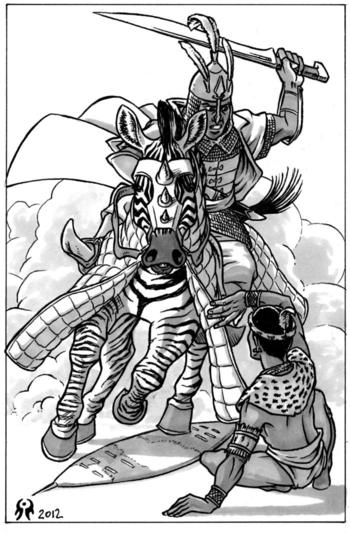
Horses are a common feature in the northern Three Lands. Nyala's army makes use of horse-zebra hybrids, scouts for Sokone merchant caravans ride them, and the Kirsi's cavalry are the best in the land. Although horses largely share the same stats, different breeds have unique features: the sturdy hill barbs ignore movement penalty on hill terrain and roll twice per hit die, taking the best result; pit ponies are bred for mine work and never panic underground and nimble enough to go wherever a human can go; Imperial zebras are the pride of the Nyalan Empire and gain +2 hit points per hit die and attack rolls.
Humans of the Three Lands come in all walks of life and occupations, and thus don't have a typical stat block. Instead there are six common types the PCs are likely to meet or fight; commoners, bandits, soldiers, elite soldiers, nobles, and merchants. None of them are impressive stat-wise, with only the noble going above 2 hit dice, and their effectiveness in combat is largely determined by available weapons and armor.
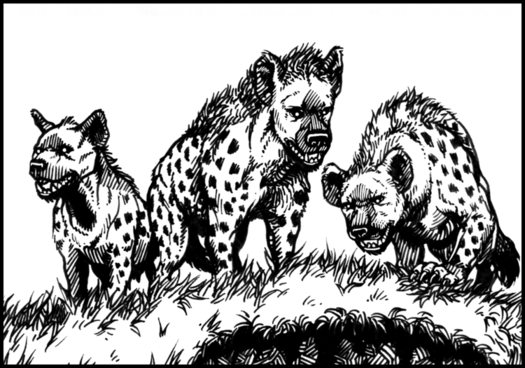
Hyenas are pack scavengers fond of stealing prize kills from larger predators. Humans see this as being against the natural order and view sightings of such animals as an ill omen. In Spears of the Dawn, all Dire animals are spirit versions of their normal counterparts. In the case of Dire hyenas, they're possessed of a wicked intelligence and fond of feasting on human leaders and nobles.
Ilomba, the Witch-Snakes are serpentine servants of the Gods Below. They seek out suitably talented cultist leaders and occult scholars, offering them power in exchange for a symbiotic bond. When a bond is formed, the serpent can take the form of the human and grant them immunity to non-magic weapons and minor spellcasting ability. However, if either the human or Ilomba dies, then both die.
Kishi, also known as the Two-Faced Ones, are evil spirits who take the forms of handsome and beautiful humans with thick braids of hair. They seduce people to accompany them to an isolated location alone, whereupon their head turns around to reveal their second hyena-like maw to eat their new victims! They operate in both rural regions and urban centers, carefully planning their attacks to avoid detection and choosing prey who are unlikely to be found or missed.
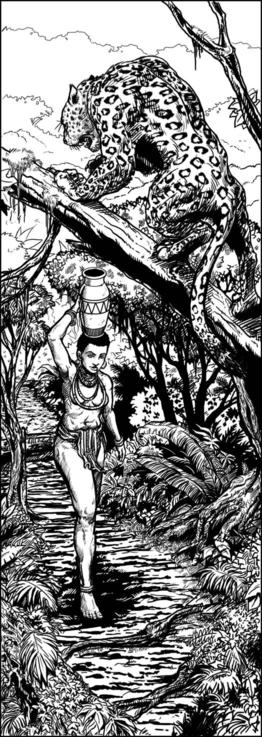
Leopards are cunning predators found and feared throughout the Three Lands. They are wary of humans in groups, although they've been known to hunt and eat them in desperate times. They are swift runners and fast climbers, easily able to evade the reach of common hunters and soldiers. Leopard-skin cloaks are viewed as status symbols, and the pelt of the mighty Dire leopard can fetch a high price on the marketplace.
Leopard Cultists are humans who pledge allegiance to malevolent and bestial spirits in exchange for gaining the powers of a leopard. They form secret societies, kidnapping folk to sacrifice to their patrons in exchange for gaining these special abilities. Most cultists are normal humans, but a few adepts blessed by the spirits can transform into leopards or a hybrid form.
Lions are noble felines of the savanna. They hunt wildebeests and zebras, and are even known to take prey claimed by leopards, cheetahs, and hyenas. Statwise they're a lot like leopards except slower, stronger, and tougher. Dire lions are arrogant creatures which seek to become rulers of the land that they survey, and any human settlements falling under their gaze are forced to worship them with human sacrifice or be slaughtered.
Moatia, known as the Dwarf Sorcerers, are short limping folk with a foul disposition. They are famous for their mastery of herbal lore and the magical arts; people seek out their huts deep in the forest to heal some incurable disease or end a plague. Moatia are easily offended and hateful to all living creatures (especially their own kind), and are fond of casting curses at those who don't show them the proper respect.
The Night Men are humanoids who live south of the Akpara River at Lakossa's border. They are hairless and bear all manner of ugly scars and deformities, and crippled Lokossans take to growing their hair extra-long to not be mistaken for a Night Man scout. Night Men live in the ruined cities of the southern jungles, subsisting on strange crops and pend most of their lives fighting each other. Every so often a particularly skilled warchief or priest unites the Night Men to lead a large horde against the Lokossans, embroiling the entire country in prolonged jungle warfare. Nobody knows why they do this or their origins.
Ningiri are reptilian beasts with the body of a crocodile and a long sinuous neck. They often hide their 30 foot long bodies behind cover while their head quickly snatches any surprised prey. They are of animal intelligence, but very cunning and dangerous.
Obia are hulking, jackal-like spirit-beasts who are hired by witches to serve as household guards and to kidnap women for wives (no respectable father will allow his children to marry a witch). Their grip is so sure that a successful attack grapples and immobilizes a target.
Rhinos are tough-as-nails beasts of the savannas and grassland, fond of charging anything they consider a threat (which includes a great many things). A sick or injured bull rhino can be devastating to a village, viciously fighting to the bitter end heedless of its survival.
Humans often call the rodent-like Rompo "singing jackals," even though it bears little resemblance to such a creature. They haunt graveyards and tombs, surviving off of the rotting flesh of humans as it sings sweetly and softly. They're intelligent as a human, and often hide bodies of murdered folk to feast upon later. In groups they might even adopt the use of tools and weapons and wear clothing obtained from corpses, and their united melodies can mesmerize those who listen to them.
Sasabonsam are winged people who lair in jungles and high mountain peaks. They nimbly snatch traveling humans off the ground to carry back to their lairs to sacrifice to their bat-like gods. Those few survivors tell that their cavernous aeries are home to evil nganga working with them, and a few are certain that the Moatia are their leaders. Sasabonsam can wield objects and weapons in their talonlike feet, and can be motivated to work with evil humans with sufficient promise of reward.
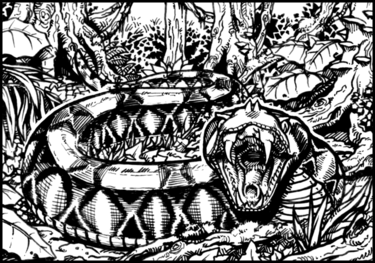
The Three Lands contain countless breeds of snakes, but the ones detailed in the Bestiary are regarded the most dangerous to humans. Giant vipers can grow as big as a man and their poison can bring down an adult buffalo. The black python, which can grow up to 20 feet in length, crushes its prey with mighty constrictions. The assassin snake possesses an alien intellect, and accepts blood sacrifices from worshipers of the Gods Below to sneak into a hated foes' houses to poison and kill them.
The Umthali are a race of humanoid serpent folk descended from Gods Below-worshiping mortals whose blood mingled with that of snakes. They constructed many grand and terrible cities while humanity was freshly created, and in the days of recorded history only one city remained. This city went to war with Sokone's ancestors and lost, and now the remaining Umthali live in scattered cells. A few Umthali are accomplished nganga or marabout, and those who can pass for human often worm their way into human centers of power.
Walking Corpses are possessed by angered souls unable to escape, lashing out at their inability to depart to the spirit world. Like ghosts, they're often created as the result of improper burials and linger around the places of their death. Fun fact: the concept of the zombie originated in African folklore.
Witches are humans who possess the potential for working ashe, but are either unaware of it or did not receive the proper training to become a nganga. They are both male and female and can be found wherever humans gather. Witches are capable of casting minor spells and rituals, but are oftentimes uncontrolled and manifest from unconscious desires. Due to this, villages and towns make an effort to recruit ngangas to properly train witches so that they don't inadvertently harm their neighbors and family.
Witches are capable of being self-taught, the most infamous rivaling the powers of learned nganga. The temptation to use one's powers is great, for it takes only a moment's thought to inflict a harmful spell with a wrathful thought, and most witches hide their powers out of fear and shame. It's possible for a nganga to "cure" a witch of their powers with a curse-removal spell, although said witch must genuinely want to be rid of the burden.
Libertad's Thoughts: The bestiary is both well-sized and diverse, and should provide GMs with plenty of adversarial fodder and a useful system to create their own creatures and NPCs.
Next time Chapter 8: Treasures and their uses!
Treasures and Their Uses
Original SA post
Chapter 7 Continuation: Spirits and Spirit-Beasts
I forgot one last table in the bestiary: generating stat blocks for spirits! It's a lot like the chapter's initial table of making new monsters, although the roles and abilities are slightly different. You've got sample stat blocks of Restless Ancestors who fight with a manufactured weapon, Raging Spirit-Beasts who have natural attacks, a Spirit of Dark Lore who can cast marabout spells, and the might False God with 12 Hit Dice and can attack twice in a round!
Humanoid and Spirit-Beast traits are divided into 2 separate tables and include things like being invisible save in reflections, possessing bronze talons or obsidian claws and the like, covered in a cloud of miasma or flames, etc. Qualities include things like being able to teleport between plants, can raise the dead as Walking Corpses, can discern someone's worst crimes by scent, breath weapons, and other cool stuff. It's a great way to show off the sheer variety of spirits.
Chapter 8: Treasures and Their Uses
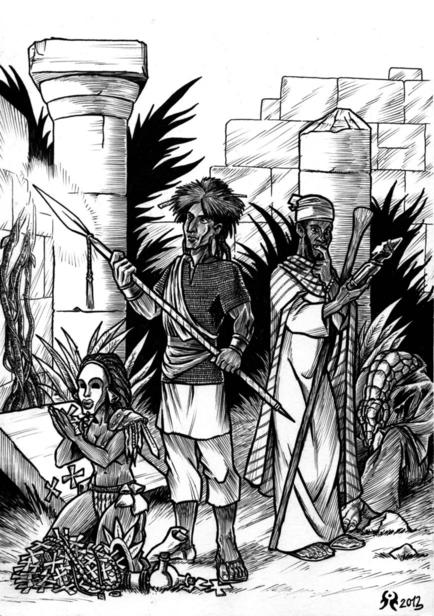
This chapter mainly describes magic items, but it also discusses other things such as buying land and building houses, hiring minions, and types of treasure troves. As Spears of the Dawn does not abide by a wealth-by-level or "treasure by CR" format, types of treasure to be found in dungeons, monster hordes, and the personal possessions of NPCs is determined by a general guideline chart.
A peasant family's saving might include a mere 1d6 x 10 silver ingots plus some spare clothes and cheap jewelry as a wedding dowry, while a powerful bandit leader would have 1d6 x 1,000 silver ingots, some expensive gems and percentage chances for magic items. The trove types are very all-encompassing, covering everything from a village tax treasury to a Giant's ruined palace. We then have some tables for generating plunder, or the value and qualities of clothing, gems, furniture and the like. And of course a table for determining what magic items adventuring Spears might find!
Magical Item Descriptions
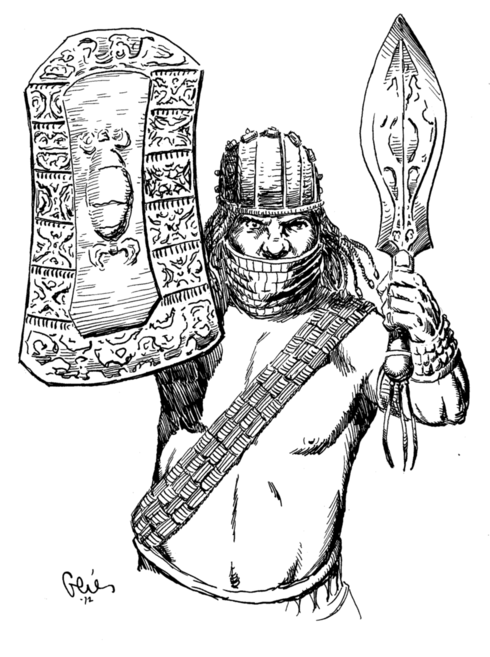
Now this is what I'm talking about! Like many other things, Spears of the Dawn's magic item system is a feature apart from the other retro-clones on the market. Basically, magic items are split into two categories: greater and lesser.
Lesser items are minor trinkets crafted by nganga, potions brewed by herbalists, and other objects of minor power. Even then such items are quite expensive for the average commoner, but even an occult scholar or village shaman might possess the means to fashion an amulet of warding against curses or a healing potion. In game terms, they're limited-use items.
Greater items are objects of legend. They are fashioned by mighty sorcerers and marabouts, infused with power after some mighty deed, and other powerful objects of lasting utility. The bound spirits of the items are semi-aware and take great offense when people try to trade them for mere gold or other banal favors, refusing to function for those who disrespected them. Greater items still have a cost, but this is only for the purposes of crafting. In game mechanics, they include weapons, armor, and other permanent items.
There are rules for crafting magic items. Basically the creator needs to pay the cost and labor for 1 day per 500 gold pieces. I think that this might be an error, as silver ingots are the universal standard elsewhere in the book. Generally speaking the crafter must be of a minimum listed level and a nganga, but it is possible for other people to craft items if they possess knowledge of an appropriate spell or possess certain skill levels (experience levels are still universal). For example, anybody of at least 2nd level and 1 rank in Occult and Healing can craft a healing potion, whereas someone of at least 4th level and a Blacksmithing level of 3 can craft a +1 weapon or armor. Overall I like this: it's a great thematic way for things like legendary artisans crafting fabled blades, or a skilled hunter concocting a potent brew with rainforest plants.
Potions are single-use lesser magic items which are typically stored in a calabash gourd stopped with clay or a glass vial. Brewers in cities must buy ingredients, but those in rural regions and the wilderness can once per year gather 1,000 silver ingots worth of material product; this is because many small villages rely upon local flora which blooms at the right time to craft their goods. There are 12 potions listed, which include classic staples such as healing injuries and sickness, shapechanging into an animal for limited periods, breathe underwater, make someone fall in love with you, and even ones which can allow you to fly (as spirits carry you) or turn invisible!
Spirit Tokens lesser magic items, usually taking the form of small amulets of inked leather or bundles of ingredients. They can be crafted by only nganga and marabout, and either represent a special appeal to patron spirits or concentrated ashe. They contain one use of a stored spell which can be released on command by a proper trigger command determined by the crafter (which can be determined by those who don't know with a successful Occult roll). Nganga and marabout can only imbue spells they have access to in spirit tokens.
Scrolls, basically.
Fetish Sticks are lesser items which are rods as long as an adult's forearm. They are usually decorated with carvings, feathers, woven cords or bones in rural regions, and wrought bronze, gems, and precious metals in urban areas. Fetish sticks each have a singular power, but can use it as many as 50 times before it crumbles away to dust. The more charges which are expended, the more battered and decayed the fetish stick becomes. The powers of a fetish stick can be activated by a command word chosen by the creator (who can only be ngangas). There are eight fetish sticks and none of them are keyed off of existing spells: they include powers such as the ability to mentally command a flock of birds, forcing a target to experience the pain of driven nails into their flesh like the ones adorning the stick, forcing a shapeshifter to return to their normal form, and even shooting out a beam of fire!
And that's it for lesser items.
It's getting late now, so I'm going to cover the rest of Chapter Eight tomorrow.
Next time, Greater Magic Items, the Converting and Spending of Treasure, and more!
Treasures and Their Uses Part 2
Original SA post
Chapter 8 Continuation
Now we're getting to the meat of Greater Items.
Normal masks are components of many rituals, imbuing wearers with the depicted qualities and the strength of the spirits and ancestors. Masks of Power are greater items a league above, carrying such power that even folk ignorant of the subtler rituals can use them. Nganga expecially prize such treasures, making it easier for them to wield ashe. Anybody may make use of a mask, although some of their powers are useless to some classes. Masks of power are limited in that a wearer must either consecutively wear it for several hours to make use of its powers, or can only be worn a few hours per day due to the stress of the wearer's body supporting two spirits at once. Only nganga can craft masks of power, and they must be at least seventh level to do so. Sample masks include the ability to perceive magical items, effects, and curses; the ability to tell if a statement is deliberately false; the ability to prepare additional spells per day; the ability to harm, speak, and see spirits; and the ability to impersonate a single human.
Magical Arms and Armor are greater items imbued with powerful spirits. They are honored objects who take offense to disrespect and can cease to function until appeased by a nganga's arts. Using them as workman's tools, trading it for gold or land, or even complaining of its inferiority to another weapon or armor can earn the spirit's wrath. All magic weapons and armor have a bonus ranging from +1 to +3; weapons' enhancement bonus adds to attack and damage rolls (thrown weapons automatically return to the wielder's hand), while armor subtracts from the wearer's armor class (lower is good); there are no magic shields in existence.
Some weapons and armor have special properties in addition to enhancement bonuses, which is dependent upon the connection to a certain greater spirit dedicated to a particularly mighty god. In short, there are 6 qualities for every major spirit-deity, 3 intended for armor and 3 intended for weapons. For example, arms and armor of Aganyu (spirit-deity of fire and wrath) include properties such as fire immunity, inflicting fire damage on enemies, extinguishing fires, and the like. A lot of these qualities have some interesting out-of-combat applications as well; for instance, the Raining property of Olakun (spirit-deity of water, rivers, and wisdom) can pour out 20 gallons of fresh water per day, while the Slowfalling property of Oya (spirit-deity of storms, winds, and travelers) grants immunity to falling damage.
Finally we end this section with Miscellaneous Magic Items, all the items which do not fit into any earlier categories. As usual, permanent or continuous use items are greater, single-use are lesser. They include such things as the Golden Fruit which releases flesh-eating swarms of insects onto enemies; the Igbako of Plenty, a food scoop which can create enough food for 12 people daily, but food created must be provided freely or its powers cease to function; a Plot-Revealing Whistle which can create copies of verbal schemes uttered against the wielder by others when blown; a Serpent-Warding Ring which grants immunity to the venom of reptiles; a Talisman of Virtue etched with text and pictures of a particular good deed/taboo (chastity, pacifism, etc) which grants a bonus to one's Charisma modifer if they adhere to said virtue; and other interesting items.
The section ends with advice on designing new magic items, specifically common guidelines to ensure that such things are not unbalanced. Basically, armor class bonuses should be unlimited to prevent PCs from becoming unhittable in combat; damage bonuses should range no more than 1d6 or 1d10 (the latter which can affect only a very limited set of enemies); skill bonuses should be capped at +1, +2 for the mightiest artifacts; and those which replicate the effects of spells should be no more than a 1/day power. Additionally, the GM must consider if the item's power can trivialize too many common encounters or challenges, or can break the premise of the game.
At times the PCs might want to create a magic item which can add to the splendor of the world or help people, but is generally not useful for adventuring. They might want to fashion a magic well to sustain a desert village, a bridle which allows a horse to travel from one point of a nation to another in a day's time. The author says to go along with it, in that it can be a good way to encourage PCs to act selflessly, find good ways to spend their treasure and money, and it's balanced by forcing them to spend one of their five lifetime uses of greater item creation.
I like this compromise regarding magic items and the economy: instead of low-magic campaigns where healing potions are the stuff of legends, there are minor charms and trinkets for sale but quite out of range of most people. And the five-per-person cap of greater magic items and their spirits' unwillingness to be treated like common trade goods (rewards for great quests and acts of heroism are okay) provide in-setting reasons for why spellcasters haven't revolutionized the world.
Converting and Spending Treasure
This section talks about what happens once the PCs haul their plundered treasure back to civilization. As is to be expected, it's a lot more common than heading to the nearest marketplace and simply selling everything. Generally speaking, small villages can buy up to 500 silver ingots' worth of goods before they run out of liquidity. Market towns and major cities can buy up to 10,000 and 100,000 silver ingots worth of stuff respectively before the laws of supply and demand kick in and render the rest of the PCs' valuables cheap. The settlements of Sokone can handle double these values, while the nomadic Meru have little need to coins and gems which are 90% less. There are no banks in the Three Lands, and goldsmiths and moneylenders can be persuaded to hold onto the PCs' treasure for a time with a 1% of the loot per week (although they might not have the facilities to keep them truly safe and might be tempted to skim off the top).
Adventurers find it wise to make friendships and ties to the local communities, who will be more trustworthy to guard their valuables in exchange for their good deeds. Or invest it in building strongholds and buying land, which are harder for thieves to steal. As the book says, "golden ingots can be stolen and gems can
be squandered, but land and stout walls are harder to lose. Wealth put into the bellies of hungry peasants can buy the kind of service that market-hired minions would never give."
The Hiring of Magical Aid
There comes a time in an adventurer's life where they might need the services of a spellcaster; perhaps they lack the knowledge required to exorcise a vengeful spirit from a house, or maybe the dropped ceremonial knife at the murder scene can be divined to gain insight to the killer's whereabouts. Generally speaking, minor practitioners can be found in villages and towns, although simply walking up to them and forking over some coin is rarely so convenient. Truly powerful marabouts and ngangas are rarely, if ever, present in cities amid the teeming masses; they usually live deep in the wilderness, presiding among ancient temples of great spiritual significance or plumbing the ruins for occult lore. In the case of Lokossa, the greatest spellcasters are too busy running the government with tight-fisted cruelty to bother with the immediate concerns of adventurers.
Spellcasters who are part of a community and exchange their magical talent for goods are generally 1st to 5th level, and can be approached by adventurers amid a long waiting queue of commoners beseeching them for their individual needs and woes. Such spellcasters expect to be rewarded with "gifts" and "tokens of respect," usually amounting to 50 silver ingots for a 1st level spell, 250 for a 2nd-level spell, or 1,000 for a 3rd-level spell. Others will be eager to utilize the services of a skilled band of adventurers and ask them to perform minor quests and favors in addition to or in lieu or hard coin and trade goods.
Spellcasters of 6th and 7th level in civilization are renowned for their power, and can afford only to listen to chiefs, obas, and other leaders, their eyes on the big picture for tasks best solved by adventurers. 4th level spells can cost as much as 4,000 silver ingots and leaving behind occult connections with the caster to help ensure that they don't go back on their pledges.
Hirelings and Servants
Adventurers can hire people, whether to accompany them on adventures or to help perform some task. They include such common roles as artisans, guardsmen (who have Commoner stats but have leather armor and hand weapons), guides, porters, priests (no spellcasting), sages, and other occupations. Their cost is calculated based on a per-day basis or "permanent hire" with is a single flat cost to represent hiring them indefinitely. Hirelings are assume to have Level 1 in related skill of their profession, while Level 2 costs ten times as much. Those with Level 3 in a skill are the best in the kingdom, and their services are rarely bought with mere silver.
Guards and soldiers can be expected to tolerate ordinary dangers, but will blanch at going into Eternal tombhouses or fighting particularly vicious and powerful monsters. In that case, a PC with a good Leadership and Charisma might be necessary to ensure the loyalty of minions.
Henchmen and Retainers
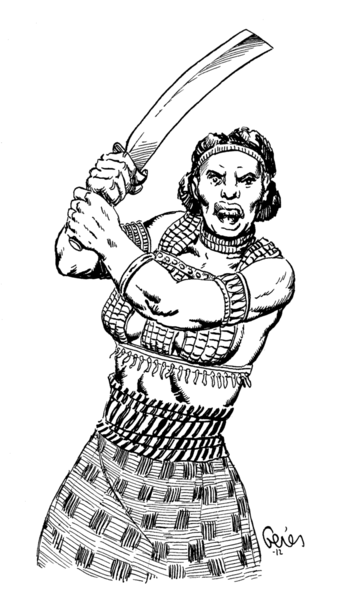
There are times when mere hirelings and servants are not enough. The PCs need assistance beyond their immediate numbers and find some talented help to fight a mighty beast or thwart an evil mastermind. In this case, there are Henchmen and Retainers.
The PCs must spend several days searching the local community of the best candidates, and even a single village might house 1d6 such souls after the rest are winnowed out. Henchmen are NPCs who have levels in classes; the majority of them are 1st level Warriors, but a certain result on a 2d6 roll might produce a griot (4), a marabout (11), or nganga (12). Henchmen require a specific employer, and might expected to be paid in advance with surety money to go to their family in case they never return (some of which might be given back to the PCs upon their safe return). Players can be in direct control of one henchman and control their actions much like their own PC, but they don't have the steel-hard resolve and courage Spears have, and if they face a near-death experience the PC must succeed on a Leadership roll to convince them to keep adventuring with the PCs. One too many close shaves will eventually result in automatic failure, as they'll come to the conclusion that the adventuring life isn't for them.
Retainers, on the other hand, are different. They are NPCs whose respect and loyalty has been earned for past favors and shared dangers. They include villagers whose people have been saved from monsters, whose family was saved from a sorcerer's curse, and other such things. It is up to the GM when an NPC becomes potential retainer material, but can generally be expected to perform more dangerous and responsible tasks than even henchmen. They are not necessarily servants for life, and gifts of 100 to 1,000 silver ingots would not be inappropriate for particularly important favors for an old friend. For those whose services are called on only occasionally, a lot will be willing to perform work out of gratitude for such great heroes.
Buildings and Real Estate
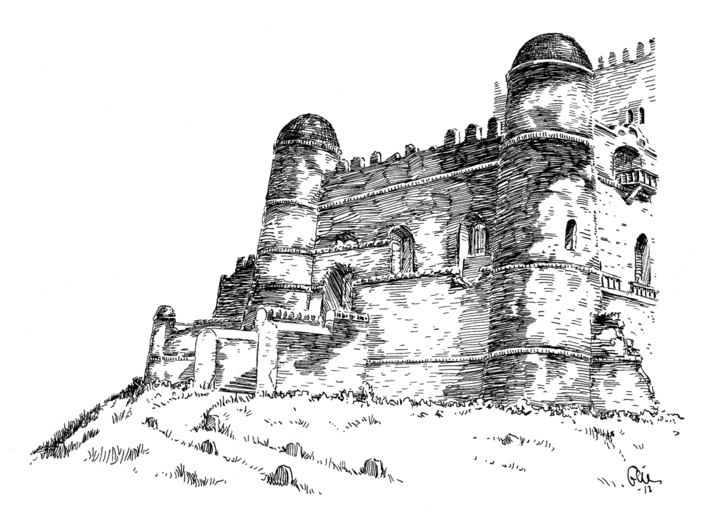
The most successful adventures soon find that a life on the road is no longer practical. They are too exposed and too well-known to the enemies they have made. Acquiring land for permanent dwellings and fortresses is how the ancestors of great heroes and nobles established themselves, after all.
Acquiring property in villages is more complicated than just buying it. Villages are a tight-knit collection of mutual aid; people must be able to trust their neighbors and rely upon them to set aside personal quarrels in the face of external danger. Those wishing to settle down on a long-term basis must prove that their addition to society will be a positive one. Newcomers are expected to participate in village rituals, share tribute and service dues, and respect local customs. The financial aspects are trivial enough that they're not worth recording for PCs.
Town life is simpler in that there are enough landowners and mercantile clans to sell space within the walls at a premium price, and new owners are expected to do nothing but pay taxes and avoid the oba's displeasure. Although they can be finer than a humble village dwelling, they are less secure in some ways. A band of foreign assassins can pass through a metropolis amid the throng of travelers, but in a remote rural setting they'll stick out like a sore thumb.
Building costs are abstracted in that the PC draws a rough outline of the kind of structure they want, and pays a price related to the size of the structure and the materials (per 10' cube). A simple ten foot hut of unadorned wood and thatch would cost 50 silver ingots, while a 100 foot square stone build with three floors would cost an expensive 30,000. Building material which is scarce in the region (such as wood in the savannah or stone in the rainforest) can double or even triple the base price. Buildings with ornate designs, statues, and the trappings of wealth cost twice as much as plainer, more practical structures. The interior of the building can be arranged as the PC wants.
Additionally there are some sample buildings listed along with price, so that the GM can abstract for similar structures. A village compound is 500 silver and 30 square feet, usually a main house and home to the richer and more important family clans. Town compounds are 7,000 silver, 50 square feet with a surrounding stone wall. Country estates and border forts are 30,000 silver, while an urban palace (built and renovated over generations and home to great obas and merchant-princes) are 75,000.
The way the building costs are set up is that the PCs might not expect to have huge, sprawling buildings, but an expensive source to spend money on and typically only feasible at higher levels. Interestingly, the sample house prices are in line, and cheaper than, the costs of crafting some of the most powerful greater magic items. I like this touch. Finally we have a table with rules for breaking down walls and doors; basically such structures have a hit point value, and the attacking weapon must be suitable for dealing damage or else nothing's accomplished (spears won't break a stone wall, no matter no many times you hit them). Magical weapons take great offense at being used this way (unless they have the Shattering property), and attacking structures is very noisy when performed in enclosed spaces and dungeons.
And so ends the chapter.
Libertad's Notes: This is another strong chapter. I like how Crawford handles the magic item economy by making such things rare and mysterious, but still allowing PCs of a certain skill level able to craft them. I do like how in comparison to traditional D&D the PCs aren't expected to save up money for essential magic items while living like vagabonds. The use of reaction and loyalty checks regarding minions and hired help makes Charisma a particularly useful stat.
Next time, Chapter 9: Gamemaster Resources (also the final chapter)!
Gamemaster Resources
Original SA post
Gamemaster Resources
This chapter is mostly filled with miscellaneous stuff intended to help GMs plan for and set up games. Although quite a bit of them are charts and tables, there's maps, sample NPC statistics, and more!
Quick Adventure Elements is a D20 table where you roll 5 times and put the results together. We have a MacGuffin, a Location, a Patron, an Antagonist, and Fighting Over column. It's not enough to make a detailed plot, but it combines some primary elements to turn into something greater. The following page has a table of Conflict Elements, which works similar but you roll for the type (Social/Military/Economic/Religious), what one side of the conflict wants/does, and things important to the conflict.
Quick Names is a series of five tables for common personal names and surnames for each culture (with the Deshurite and Meru people sharing the same one). It's a particularly great resource for new players who will be unfamiliar with African names. Crawford has some useful advice for ensuring that names are easily remembered:
quote:
The people of the Three Lands often add additional names in acknowledgement of important events or notable deeds. As Afia grows, she might distinguish herself as Afia Goodluck Mafi after surviving a dangerous childbed fever, or Afia Breaks Them All after she manages to kill a trio of night-time robbers with her father’s hammer. A person may adopt a new name at any time, but it is its use by the community that confers legitimacy on it.
When creating NPCs for a new campaign, a GM is well-advised to use names with epithets. Many of the names of the Three Lands are novel to players, and they can have a hard time pronouncing them or making them “stick” in memory without some familiar anchor as a mnemonic. “General Mantled-In-Glory” and “Lord Abazu the Unsmiling” are both much easier for them to remember than “General Mitri Menkare” or “Lord Abazu Ezekuna”. In the same fashion, new players might be hesitant or confused about giving names to their PCs that they have a hard time pronouncing. You can refer to the pronunciation guide in the foreword of the book, or just let them pick suitable epithets.
Quick Culture Generation is intended to be used for minor states and remote tribes, with tables to generate cultural qualities (culture might love to build great edifices or admire truthfulness in all things), sources of wealth, potential societal ills and curses (like a wrathful spirit plaguing the land or a large segment of society is banned from learning), and jobs they might have for adventurers.
Quick NPC Stats provides sample statistics for NPCs with class levels, separated into odd-numbered levels. The Level 1s serve well as hand-outs for new players. Quick NPC Generation is intended for personality and miscellaneous traits, such as the role they have in their family to their greatest ambitions and problems.
Quick Nganga Magic is a 1-page list of all the spells and rituals for the nganga class, as well as spells per day by level. It is useful due to the sheer size of spells available to this versatile class (the marabout and griot are more limited and thus easier to manage).
Quick Cult Flavor provides hooks and traits of secret organizations dedicated to evil entities. It includes cool stuff like a table for their secret lair (crumbled estate, slum compound, grove in the wilderness, etc), their strongest asset (strong warriors, a powerful magic item, popular support), why they are awful (enslaved by evil spirits, plotting schemes of tyrannical theocracy, desire genocide, etc).
Quick Bestiary Reference compiles the stat blocks of all the bestiary entries into one page! I can't overstate how useful and convenient this is. By looking at it I notice some peculiar things: 1, only 4 monsters total are immune to non-magic weapons. 2, there's not too much overlap in special abilities (only snakes are poisonous, only the Sasabonsam can fly, only Eternal and Walking Corpses take minimum damage from piercing weapons, etc). 3, a lot of Armor Class values range from 4 to 7. Only 3 monsters have an AC of 3, the lowest one there is (dire lion and rhinocerous and the ghost). This is interesting in that a heavily-armored PC or one with the Blessed and Graced Warrior Idahun can match them, and that magic weapons while cool are not a necessity at higher levels.
The final entry includes several pages of Quick Location Maps with a fast resource for floorplans and maps. They are sparse in detail so that GMs can scrawl in their own details. I'll show off a few of them:
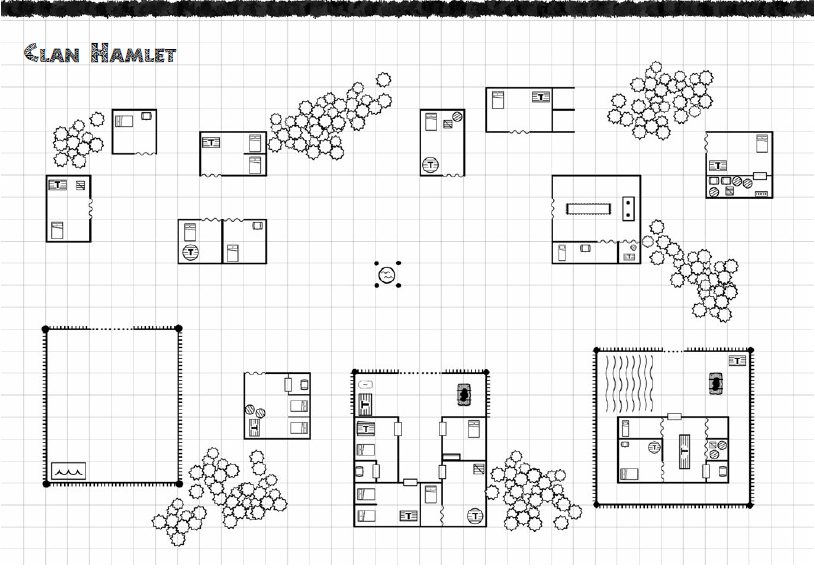
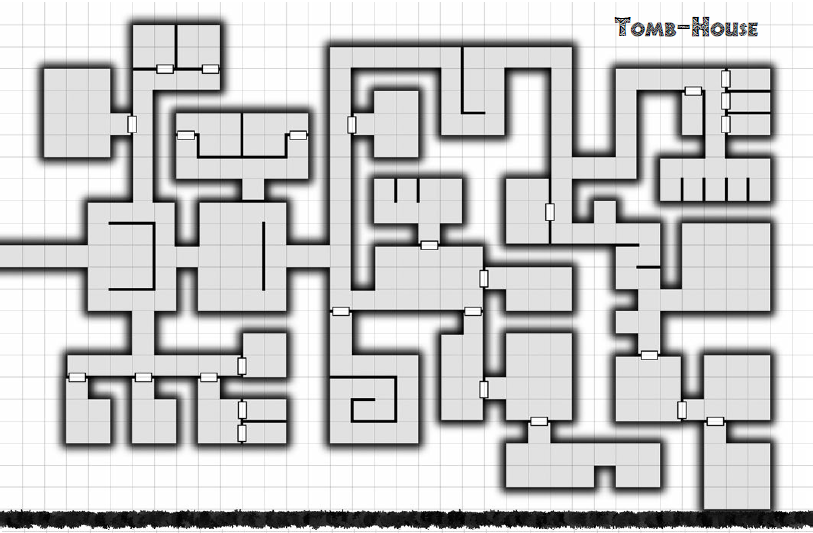
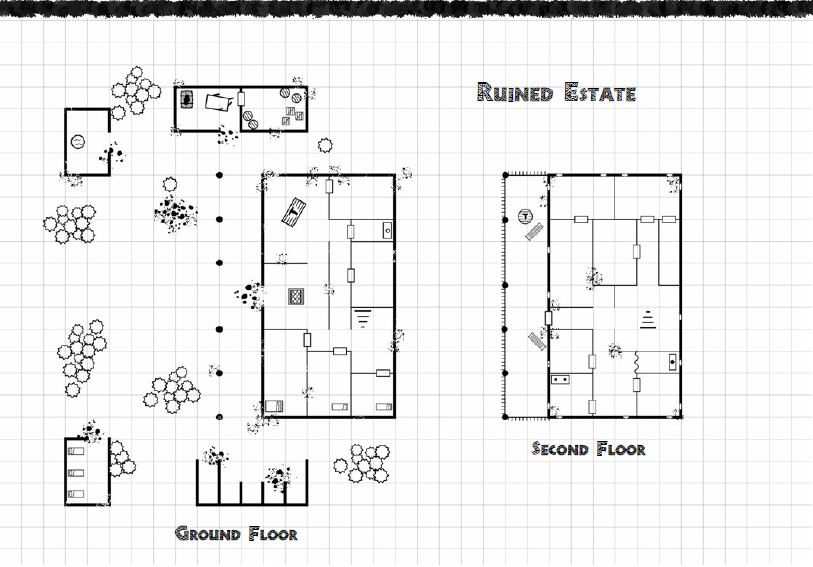
Then we have a two-page printable character sheet to end things off.
Libertad's Thoughts: Although many charts and tables can often become extraneous, the resources provided here are all very useful and relevant. My favorite is the one-page bestiary reprint of stat blocks. I don't think that you can say that for any other retroclones on the market!
Adventure: The Lost Mastaba of Khamose
The adventure provided is a short dungeon crawl for 1st level adventurers. The backstory is that a hundred years ago a troubled village was ruled by the tyrannical Lord Khamose, whose forces paid tribute to the Eternal King. He forced the people to build a tomb-house befitting his stature as an Eternal noble. In time the advancing armies of the Five Nations slew his legions and forced him into his buried mastaba . For forty years the villagers stayed away from this dungeon, but in recent days their shepherds and cattle have suffered mysterious disappearances in the western hills, and they suspect the mastaba. Adventuring Spears will be rewarded by the village if they investigate and take care of any horrors within.
In truth, a group of bandits have been using the mastaba as a headquarters for cattle-rustling. Unfortunately they dug too deep and released the Eternal into the rest of the complex, killing all but a few of them and their leader Gwoza. The survivors are trapped in a barricaded room.
The dungeon has 13 rooms, the entrance containing bloodstains of the eaten bandits. The atrium has been redesigned to resemble and outdoor garden, with clay sculpture plants and a fountain that recycles a fine silvery sand, and a silver circular ceiling painting resembling the moon. Five eternal Dreamers are feasting on bandit corpses in the dining hall, and four bandits are hiding under their beds in the sleeping chamber waiting for the next opportunity to escape (they'll attack the PCs in a mad frenzy for one round and then try to flee).
In the library is Gwoza the leader, and an Eternal who looks like a living human's posing as a nonexistant wife (Senti) who befriended the bandits before they dug down. Gwoza knows that going back to civilization means the death penalty, so he'll attack the PCs believing them to have come for him, while Senti will pretend to be a damsel in distress while waiting for the perfect opportunity to establish an Eternal cult in the next town or city.
The bandit storehouses and the storeroom contain the majority of treasure (silver Deshirite jewelry, trade ingots, and semiprecious jewels), and the nearby bathing chamber's full of fetid mold which can leave the PCs dizzy. Khamose's Chamber is way in the back, and his chamberlain Ushab is now an Eternal noble who's taken over the quarters. He's quite powerful but has reduced hit points than others of his kind and stature (due to wounds suffered slaughtering the bandits). In a chest is more treasure of trade ingots, and he wields serpent-headed staff as a +1 runku (war-staff).
Libertad's Thoughts: The dungeon can be quite lethal if the PCs go through it too fast. There's 11 Eternal Dreamers, one Walking Corpse, four bandits and their two guard dogs, and the aforementioned named NPCs. Given that Eternal take minimum possible damage from edged weapons (this is common knowledge to Spears), a party with warriors decked out in swords and bows will have a very bad time. If you're introducing newcomers to the game or players of less lethal RPGs, I'd recommend toning down the number of opponents if that might turn them off the game.
Bibliography
Aside from the Index, this is the last entry before we end our read of Spears in the Dawn. During the creation process Kevin Crawford spent two months brushing up on African history, folklore, and mythology. Even though this RPG is a pastiche of Africa rather than being historical, these materials (which are include fictional material) provided great inspiration to him. He hopes that the rest of us might find it useful, both for searching for things to add to home games as well as entertaining reads in and of themselves.
quote:
Fiction
“Sword & Soul” is a touchstone for Spears of the Dawn, taking many of the familiar tropes of sword and sorcery fiction and placing them within the setting of historical or fantastical Africa. The present dean of the genre is Charles Saunders, whose Imaro practically defined the type. The following list is simply a starting point into the genre, one chosen for the breadth of authors rather than a deep focus on any particular series. Several of the books below are parts of a longer series, most of them well worth following.
Changa’s Safari, by Milton J. Davis
Griots: A Sword & Soul Anthology, edited by Milton J. Davis and
Charles R. Saunders
Wind Follower, by Carole MacDonnell
Timbuktu Chronicles: Aida and the Chosen Soldier, by Anthony
Nana Kwamu
Chaka: An Historical Romance, by Thomas Mofolo
Once Upon A Time in Afrika, by Balogun Ojetade
Imaro, by Charles R. Saunders
History and Culture
A quick dip into these books can provide a vast trove of NPCs, places, and conflicts to translate into your own game. Particularly with older texts, the observations should sometimes be taken cum grano salis, but even wild fancies can provoke your imagination.
The Royal Kingdoms of Ghana, Mali, and Songhay: Life in Medieval
Africa, by Patricia and Frederick McKissack. While very much a popular book in writing style, it contains maps and a clear, crisp overview of medieval Africa. Particularly useful for its description of the sometimes-ambiguous sources and pointers to other books.
The history and description of Africa and of the notable things therein contained, by Leo Africanus. Born in 1494 as al-Hasan ibn Muhammad al-Wazzan al-Fasi, Leo Africanus provides a firsthand description of northern Africa in the sixteenth century. Not all of his observations were his own, but his visit to Timbuktu helps to detail the vibrant life of a fabulously prosperous African trade city.
‘The History of Ashanti Kings and the Whole Country Itself ’ and Other Writings, by Agyeman Prempeh. Begun in 1907 by the Asantehene Prempeh I, the essays in the front of this book are of less interest than the history itself, which is told from the perspective of the exiled king who prepared it.
Dynasty and Divinity: Ife Art in Ancient Nigeria, by Henry John Drewal and Enid Schildkrout. This book is useful in providing examples of sophisticated, beautiful artwork in metal, terra-cotta, and other materials. You can use the descriptions to flesh out palaces and come up with characteristic art treasures for your PCs to plunder, as well as get a hint of the subtle religious and aesthetic values that underlay the creation of such works.
Mythology and Legends
A GM can take their pick of myths and legends. Gruesome beasts and quarrelsome spirits make good monsters for your PCs to
face, and the marvelous artifacts and tokens of the myth make for handy magic item templates that your players are unlikely to have found a dozen times before.
A Dictionary of African Mythology: The Mythmaker as Storyteller, by Harold Scheub. Fairly popular in character, this book is full of short myth and legend synopses that often feature religious or mythological figures. If you can’t get the other books on this list, this one provides a great deal of grist and a useful bibliography.
African Folklore: An Encyclopedia, edited by Philip M. Peek and Kwesi Yankah. A magisterial volume, you can flip this one open and find something interesting on almost every page. The brief treatments are ample for most game uses.
Religion
The warning made earlier about not taking a part for the whole applies particularly to matters of religion. Different regions and cultures can hold drastically different cosmologies and religious practices. Disputes over the “real meaning” of rites or customs are common, and you can expect to find as much disagreement over subtleties and particulars as you would find in any other living religious tradition. Finding good books in this field is difficult- many of them on the market are popular works intended to provide religious guidance to believers rather than the raw grist most useful to a GM. Those books that take a more scholarly perspective can be hard to find without recourse to a university library.
Encyclopedia of African Religion, edited by Molefi Kete Asante and Ama Mazama. Check for this in a good academic library if you have access to one, as the price tends to be prohibitive to casual users. If you can get access to it, however, you’ll have the use of a volume that is remarkably exhaustive on the details and specifics of African traditional religion.
Religions in West Africa and Ancient Egypt, by Jonathan Olumide Lucas. A very hard book to acquire, but the author’s eagerness to show derivation between ancient Egyptian and precolonial traditional religion is useful to a GM, as he provides many examples of rites and customs by which to bolster his argument. Whether or not you find it persuasive, you can use the ritual material.
West African Religion: A study of the beliefs and practices of Akan, Ewe, Yoruba, Ibo, and Kindred Peoples, by Edward Geoffrey Parrinder. While first published in 1949, with all the baggage that implies, Parrinder provides the kind of direct observation that is sometimes harder to find in more modern texts. Details on specific practices are particularly useful for GMs who want flavor and detail for religious rituals and marabout customs.
West African Traditional Religion, by J. Omosade Awolalu. Not an easy book to get, but it provides a useful and necessary perspective from a scholar with intimate cultural familiarity with the region.
Visual Resources
One particularly useful resource is the International Mission Photography Archive curated by the University of Southern California. This is an enormous collection of missionary photography largely from the late eighteenth and early twentieth century, and a good deal of it is pertinent to Africa. While many of the photographs and postcards depict the rapid cultural and technological change that was in effect at the time, others show details of dress, traditional buildings, important local officials, and other visual details that are hard to find elsewhere. Browsing through the collection can give a GM a great many ideas about NPCs and places of interest for their campaign. It can presently be found at http://digitallibrary. usc.edu/cdm/landingpage/collection/p15799coll123
And this concludes our reading of Spears in the Dawn! What a wonderful book! It's clear throughout that this is a work of love, fashioned by one dedicated not only to making an engaging respectful treatment of fantasy Africa, but a good concise game unafraid to toss out staple rules and tropes prevalent in other D&D games to make a better experience. I hope that my review has brought new-found attention and interest to what is easily my favorite OSR game by far. My final verdict on this product is a Must Buy. Even if you're not a fan of OSR games, it contains enough working parts and cool things that players of "New School" games can appreciate!
I plan on giving an in-depth review of Dreamscarred Press' Path of War next, a chapter-by-chapter analysis like I did this book. I'm eager to see you all again soon!